Whole-Exome Sequencing of 21 Families: Candidate Genes for Early-Onset High Myopia
Abstract
1. Introduction
- Regulation of microenvironmental factors such as the level of angiogenic growth factors (VEGF, MCP1 and IL5) or proinflammatory cytokines (IL6, IFN-γ, IP-10, eotaxin and MIP-1α) in the aqueous and vitreous humors [3].
- Visual feedback driven by optical defocus. The defocus signal is detected by the retina and triggers a multilayered signaling cascade involving a large number of coding and regulatory genes, sequentially affecting the retina, retinal pigment epithelium (RPE), choroid, sclera and its extracellular matrix (ECM). In this last step of the cascade, changes occur in the composition of the ECM and are reflected in axial elongation (Figure 3). Alterations in these genes and their function can disrupt emmetropization and result in excessive axial length [2].
2. Results and Discussion
2.1. OFT-00074 Family
 | ACMG Criteria | ACMG Result | Variant | Zygosity | Inheritance | Total Families | Model of Inheritance | Gene Reported by |
|---|---|---|---|---|---|---|---|---|
| ARHGEF18 | PM2 | VUS | NM_015318.3:c.2167C>T:p.(Arg723Cys) | Het | Unknown | 1 | AR | [16] |
| KDM6B | PM2, BP4 | VUS | NM_001080424.1:c.1582C>T:p.(Pro528Ser) | Het | Unknown | 2 | Unknown | [17] |
| TRPM1 | PVS1, PM2, PP5 | P | NM_002420.5:c.1023+1G>A | Het | Unknown | 2 | AR | [10,11,12,13] |
2.2. OFT-00097 Family
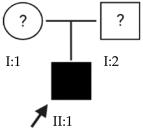 | ACMG Criteria | ACMG Result | Variant | Zygosity | Inheritance | Total Families | Model of Inheritance | Gene Reported by |
|---|---|---|---|---|---|---|---|---|
| ADAMTSL1 | PM2 | VUS | NM_001040272.5:c.1819G>A:p.(Glu607Lys) | Het | Unknown | 1 | Unknown | [15] |
| CACNA1F | PVS1, PM2, PP5 | P | NM_005183.3:c.4504C>T:p.(Arg1502 *) | Hemi | Maternal | 2 | XL | [22,24] |
| COL9A2 | PM2 | VUS | NM_001852.3:c.1652C>T:p.(Ala551Val) | Het | Unknown | 1 | AR | [20] |
| CSMD1 | PM2 | VUS | NM_033225.5:c.1712A>G:p.(Asn571Ser) | Het | Maternal | 4 | Unknown | [19,23] |
| FBLN1 | PM2 | VUS | NM_006486.2:c.1157C>T:p.(Thr386Met) | Het | Unknown | 1 | AD | [21] |
| HSPG2 | PM2 | VUS | NM_005529.6:c.12691G>A:p.(Glu4231Lys) | Het | Maternal | 6 | AD/AR | [19] |
2.3. OFT-00155 Family
2.4. OFT-00175 Family
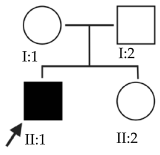 | ACMG Criteria | ACMG Result | Variant | Zygosity | Inheritance | Total Families | Model of Inheritance | Gene Reported by |
|---|---|---|---|---|---|---|---|---|
| BMPR2 | PM2 | VUS | NM_001204.6:c.1931A>G:p.(Asn644Ser) | Het | Paternal | 1 | AD | [29] |
| HSPG2 | PM2 | VUS | NM_005529.6:c.10481G>A:p.(Arg3494Gln) | Het | De novo | 6 | AD/AR | [19] |
| PCDH15 | PM2 | VUS | NM_001142769.1:c.4396A>G:p.(Ser1466Gly) | Het | Paternal | 2 | AR/Digenic | [19] |
| TRPM1 | BP4 | VUS | NM_002420.5:c.4433C>T:p.(Thr1478Met) | Het | Paternal | 2 | AR | [10,11,12,13] |
2.5. OFT-00178 Family
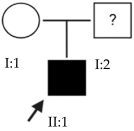 | ACMG Criteria | ACMG Result | Variant | Zygosity | Inheritance | Total Families | Model of Inheritance | Gene Reported by |
|---|---|---|---|---|---|---|---|---|
| CSMD1 | PM2 | VUS | NM_033225.5:c.8042G>A:p.(Gly2681Asp) | Het | Paternal | 4 | Unknown | [19,23] |
| CSMD1 | PM2, BP4 | VUS | NM_033225.5:c.4375G>A:p.(Ala1459Thr) | Het | Paternal | 4 | Unknown | [19,23] |
| LAMA4 | PM2 | VUS | NM_001105207.2:c.673G>A:p.(Ala225Thr) | Het | Paternal | 1 | AD | [33] |
| LRP2 | PM2, PP3 | VUS | NM_004525.2:c.10202C>G:p.(Thr3401Arg) | Het | Maternal | 1 | AR | [30] |
| MAP3K1 | PM2, BP4 | VUS | NM_005921.1:c.299G>A:p.(Gly100Glu) | Het | Maternal | 1 | AD | [31,32] |
| MAP3K1 | PM2, PM4 | VUS | NM_005921.1:c.3646_3648delATC:p.(Ile1216del) | Het | Paternal | 1 | AD | [31,32] |
| PCDH15 | PM2, BP4 | VUS | NM_001142769.1:c.1519G>A:p.(Val507Ile) | Het | Paternal | 2 | AR/Digenic | [19] |
| PLG | PM2, PP3 | VUS | NM_000301.3:c.598A>G:p.(Thr200Ala) | Het | Paternal | 1 | AR | [34] |
| VASH1 | PM2 | VUS | NM_014909.4:c.953G>A:p.(Arg318Gln) | Het | Maternal | 1 | Unknown | [35] |
2.6. OFT-00191 Family
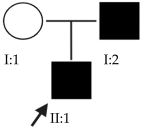 | ACMG Criteria | ACMG Result | Variant | Zygosity | Inheritance | Total Families | Model of Inheritance | Gene Reported by |
|---|---|---|---|---|---|---|---|---|
| COL11A1 | PP3, PM2 | LP | NM_001854.3:c.2900G>T:p.(Gly967Val) | Het | Paternal | 1 | AD/AR | [15,24] |
| FRMPD1 | PM2, BP4 | VUS | NM_014907.2:c.2469C>A:p.(Ser823Arg) | Het | Paternal | 2 | Unknown | [38] |
| PER3 | PM2, BP4 | VUS | NM_016831.2:c.3502A>G:p.(Thr1168Ala) | Het | Paternal | 1 | AD | [36] |
2.7. OFT-00209 Family
2.8. OFT-00217 Family
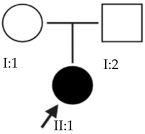 | ACMG Criteria | ACMG Result | Variant | Zygosity | Inheritance | Total Families | Model of Inheritance | Gene Reported by |
|---|---|---|---|---|---|---|---|---|
| AGRN | PM2 | VUS | NM_198576.3:c.4799C>T:p.(Ala1600Val) | Het | Paternal | 2 | AR | [40] |
| CNTN6 | PM2, BP4 | VUS | NM_014461.3:c.260A>G:p.(Asn87Ser) | Het | Paternal | 1 | Unknown | [42] |
| CNTN6 | PM2, BP4 | VUS | NM_014461.3:c.2553G>C:p.(Met851Ile) | Het | Paternal | 1 | Unknown | [42] |
| FRMD4B | PM2, PP3 | VUS | NM_015123.2:c.554T>C:p.(Leu185Ser) | Het | Maternal | 1 | Unknown | [42] |
| GRM6 | PM2, PVS1, PP5 | LP | NM_000843.3:c.3G>T:p.(Met1?) | Het | Paternal | 1 | AR | [24,41] |
| LRP1 | PM2, PP2 | VUS | NM_002332.2:c.1415G>A:p.(Arg472Gln) | Het | Paternal | 2 | AD/AR | [43] |
2.9. OFT-00223 Family
2.10. OFT-00253 Family
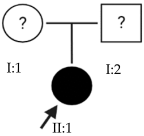 | ACMG Criteria | ACMG Result | Variant | Zygosity | Inheritance | Total Families | Model of Inheritance | Gene Reported by |
|---|---|---|---|---|---|---|---|---|
| CEP290 | PM2, BP4 | VUS | NM_025114.3:c.6791A>G:p.(Lys2264Arg) | Het | Maternal | 1 | AR | [19] |
| CPSF1 | PM2 | VUS | NM_013291.2:c.3128C>T:p.(Pro1043Leu) | Het | Maternal | 2 | Unknown | [40,45,46] |
| HSPG2 | PM2 | VUS | NM_005529.6:c.3346G>A:p.(Gly1116Ser) | Het | Paternal | 6 | AD/AR | [19] |
| MYOM1 | PM2, PP3 | VUS | NM_003803.3:c.4580G>T:p.(Gly1527Val) | Het | Maternal | 1 | Unknown | [48] |
| MYOM1 | PM2, PP3 | VUS | NM_003803.3:c.3032T>C:p.(Val1011Ala) | Het | Paternal | 1 | Unknown | [48] |
| OPN4 | BP6 | VUS | NM_033282.3:c.1411_1412insT:p.(Ser473fs) | Het | Paternal | 1 | Unknown | [47] |
| THBS2 | PM2 | VUS | NM_003247.3:c.799G>A:p.(Glu267Lys) | Het | Paternal | 2 | Unknown | [28] |
2.11. OFT-00268 Family
2.12. OFT-00332 Family
2.13. OFT-00403 Family
 | ACMG Criteria | ACMG Result | Variant | Zygosity | Inheritance | Total Families | Model of Inheritance | Gene Reported by |
|---|---|---|---|---|---|---|---|---|
| TSG101 | PM2 | VUS | NM_006292.3:c.942C>T:p.(Ile314Ile) | Het | Maternal | 3 | Unknown | [53] |
2.14. OFT-00429 Family
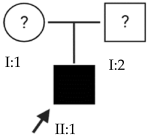 | ACMG Criteria | ACMG Result | Variant | Zygosity | Inheritance | Total Families | Model of Inheritance | Gene Reported by |
|---|---|---|---|---|---|---|---|---|
| FLRT3 | PM2, PP3 | VUS | NM_013281.3:c.325T>G:p.(Leu109Val) | Het | Unknown | 2 | AD/Digenic/Multigenic | [57] |
| HSPG2 | PM2, PM4 | VUS | NM_005529.6:c.742_744delCTT:p.(Leu248del) | Het | Unknown | 6 | AD/AR | [19] |
| HSPG2 | PVS1, PM2 | LP | NM_005529.6:c.738delT:p.(Leu247fs) | Het | Unknown | 6 | AD/AR | [19] |
| LRPAP1 | PM2 | VUS | NM_002337.3:c.298G>A:p.(Gly100Ser) | Het | Unknown | 1 | AR | [43,54] |
| MMP9 | PM2, BP4 | VUS | NM_004994.2:c.1270C>A:p.(Arg424Ser) | Het | Unknown | 1 | AR | [55,56] |
2.15. OFT-00474 Family
2.16. OFT-00477 Family
2.17. OFT-00506 Family
2.18. OFT-00546 Family
2.19. OFT-00586 Family
2.20. OFT-00601 Family
2.21. OFT-00710 Family
3. Materials and Methods
4. Conclusions
Author Contributions
Funding
Institutional Review Board Statement
Informed Consent Statement
Data Availability Statement
Acknowledgments
Conflicts of Interest
Abbreviations
| ACMG | American College of Medical Genetics |
| AD | Autosomal dominant |
| ADAMTS | A disintegrin and metalloproteinase with thrombospondin motif |
| AL | Axial length |
| AR | Autosomal recessive |
| Astig | Astigmatism |
| BCVA | Best-corrected visual acuity |
| BMP | Bone morphogenetic protein |
| CSNB | Congenital stationary night blindness |
| ECM | Extracellular matrix |
| EDP | Elastin-derived peptides |
| EoHM | Early-onset High Myopia |
| Fx | Fixation |
| GEF | Guanine nucleotide exchange factor |
| Gpsm2 | G-protein signaling modulator 2 |
| GWAS | Genome-wide association study |
| Hemi | Hemizygous |
| Het | Heterozygous |
| HM | High myopia |
| LP | Likely pathogenic |
| NA | Not available |
| NFx | Non-fixation |
| NGS | Next-Generation Sequencing |
| NLP | No light perception |
| OD | Right eye |
| OS | Left eye |
| P | Pathogenic |
| RD | Retinal detachment |
| RPE | Retinal pigment epithelium |
| SD | Spherical diopters |
| SE | Spherical equivalent |
| SPcc | Sphere with cycloplegia |
| UMOG | Multidisciplinary Unit of Ophthalmogenetics |
| VUS | Variant of uncertain significance |
| WES | Whole-exome sequencing |
| WGS | Whole-genome sequencing |
| WWP | White without pressure |
| XL | X-linked |
Appendix A
| Code | Description |
| PVS1 | Null variant (nonsense, frameshift, canonical ±1 or 2 splice sites, initiation codon, single or multiexon deletion) in a gene where loss of function is a known mechanism of disease. |
| PS1 | Same amino acid change as a previously established pathogenic variant regardless of nucleotide change. |
| PS2 | De novo (both maternity and paternity confirmed) in a patient with the disease and no family history. |
| PS3 | Well-established in vitro or in vivo functional studies supporting a damaging effect on the gene or gene product. |
| BS1 | Allele frequency is greater than expected for the disorder. |
| PM1 | Located in a mutational hotspot and/or critical and well-established functional domain (e.g., active site of an enzyme) with no benign variation. |
| PM2 | Absent from controls (or at extremely low frequency if recessive) in Exome Sequencing Project, 1000 Genomes Project, and Exome Aggregation Consortium. |
| PM3 | For recessive disorders, detected in trans with a pathogenic variant. |
| PM4 | Protein length changes as a result of in-frame deletions/insertions in a non-repeat region or stop-loss variants. |
| PM5 | Novel missense change at an amino acid residue where a different missense change determined to be pathogenic has been previously observed. |
| PP1 | Cosegregation with disease in multiple affected family members in a gene definitively known to cause the disease. |
| PP2 | Missense variant in a gene that has a low rate of benign missense variation and in which missense variants are a common mechanism of disease. |
| PP3 | Multiple lines of computational evidence support a deleterious effect on the gene or gene product (conservation, evolutionary, splicing impact, etc.) |
| PP5 | Reputable source recently reports variant as pathogenic, but the evidence is not available to the laboratory to perform an independent evaluation. |
| BP4 | Multiple lines of computational evidence suggest no impact on gene or gene product (conservation, evolutionary, splicing impact, etc.) |
| BP6 | Reputable source recently reports variant as benign, but the evidence is not available to the laboratory to perform an independent evaluation. |
| Family | Variant | Classification | Functional Annotation | GnomAD Allele Frequency | Gene | Gene Ontology Main Pathways Associated |
| OFT-00074 | NM_015318.3:c.2167C>T:p.(Arg723Cys) | VUS | missense_variant | 0 | ARHGEF18 | Small-GTPase-mediated signal transduction, negative regulation of stress fiber assembly, extracellular exosome in part of neural stem cell, regulation of Rho protein signal transduction, plasma membrane |
| NM_001080424.1:c.1582C>T:p.(Pro528Ser) | VUS | missense_variant | 0.00001577 | KDM6B | Beta-catenin binding, histone demethylase activity, metal ion binding, histone h3k27me2/h3k27me3 demethylase activity, inflammatory response to antigenic stimulus, chromatin remodeling, positive regulation of transcription by RNA polymerase II, regulation of gene expression | |
| NM_002420.5:c.1023+1G>A | P | splice_donor_variant&intron_variant | 0.00002005 | TRPM1 | Calcium channel activity, G-protein-coupled glutamate receptor signaling pathway, visual perception, cellular response to light stimulus, axon | |
| OFT-00097 | NM_001040272.5:c.1819G>A:p.(Glu607Lys) | VUS | missense_variant | 0.0001279 | ADAMTSL1 | Hydrolase activity, extracellular matrix organization, extracellular region |
| NM_005183.3:c.4504C>T:p.(Arg1502*) | P | stop_gained | 0 | CACNA1F | Voltage-gated calcium channel activity, metal ion binding, visual perception, detection of light stimulus involved in visual perception, photoreceptor outer segment | |
| NM_001852.3:c.1652C>T:p.(Ala551Val) | VUS | missense_variant | 0.00005996 | COL9A2 | Extracellular matrix structural constituent conferring tensile strength, protein homodimerization activity, skeletal system development, extracellular region, endoplasmic reticulum lumen, collagen-containing extracellular matrix, collagen type IX trimer, extracellular space, extracellular matrix organization, | |
| NM_033225.5:c.1712A>G:p.(Asn571Ser) | VUS | missense_variant | 0.00001450 | CSMD1 | Male gonad development, female gonad development, oviduct epithelium development | |
| NM_006486.2:c.1157C>T:p.(Thr386Met) | VUS | missense_variant | 0.0001520 | FBLN1 | Collagen-containing extracellular matrix, fibronectin binding, integrin binding, extracellular matrix structural constituent, calcium ion binding, peptidase activator activity, fibrinogen binding, extracellular matrix organization, extracellular region, extracellular space, extracellular matrix, extracellular exosome | |
| NM_005529.6:c.12691G>A:p.(Glu4231Lys) | VUS | missense_variant | 0.00003196 | HSPG2 | Collagen-containing extracellular matrix, amyloid-beta binding, calcium ion binding, extracellular matrix structural constituent conferring compression resistance, collagen V binding, angiogenesis, response to hypoxia, positive regulation of endothelial cell proliferation, inflammatory response, negative regulation of angiogenesis, extracellular region, extracellular space, extracellular exosome | |
| OFT-00155 | NM_005183.3:c.2924G>A:p.(Arg975Gln) | LP | missense_variant | 0 | CACNA1F | Voltage-gated calcium channel activity, metal ion binding, visual perception, detection of light stimulus involved in visual perception, photoreceptor outer segment |
| NM_001853.3:c.1258C>G:p.(Gln420Glu) | VUS | missense_variant | 0.0002642 | COL9A3 | Extracellular matrix structural constituent conferring tensile strength, protein homodimerization activity, extracellular region, collagen-containing extracellular matrix, collagen type IX trimer, extracellular matrix organization, extracellular space | |
| NM_005529.6:c.4493C>T:p.(Ser1498Phe) | VUS | missense_variant | 0.00004378 | HSPG2 | Collagen-containing extracellular matrix, amyloid-beta binding, calcium ion binding, extracellular matrix structural constituent conferring compression resistance, collagen V binding, angiogenesis, response to hypoxia, positive regulation of endothelial cell proliferation, inflammatory response, negative regulation of angiogenesis, extracellular region, extracellular space, extracellular exosome | |
| NM_005559.3:c.3958A>G:p.(Ile1320Val) | VUS | missense_variant | 0.000003977 | LAMA1 | Collagen-containing extracellular matrix, extracellular matrix structural constituent, glycosphingolipid binding, morphogenesis of an epithelial sheet, neuron projection development, establishment of epithelial cell apical/basal polarity, retinal blood vessel morphogenesis, positive regulation of integrin-mediated signaling pathway, extracellular region, extracellular space, extracellular matrix, collagen-containing extracellular matrix, protein complex involved in cell–matrix adhesion, laminin-1 complex, laminin-3 complex | |
| NM_005560.4:c.1744C>T:p.(Pro582Ser) | VUS | missense_variant | 0.000004338 | LAMA5 | Collagen-containing extracellular matrix, integrin binding, extracellular matrix structural constituent, morphogenesis of a polarized epithelium, integrin-mediated signaling pathway, morphogenesis of embryonic epithelium, regulation of epithelial cell proliferation, postsynapse organization, extracellular region, synaptic cleft, collagen-containing extracellular matrix, extracellular exosome, extracellular matrix of synaptic cleft, laminin-5 complex, laminin-10 complex, laminin-11 complex | |
| NM_003246.3:c.1122C>T:p.(Pro374Pro) | VUS | splice_region_variant&synonymous_variant | 0.00006059 | THBS1 | Positive regulation of MAP kinase activity, negative regulation of endothelial cell proliferation, negative regulation of cell–matrix adhesion, negative regulation of angiogenesis, collagen-containing extracellular matrix, fibronectin binding, integrin binding, extracellular matrix structural constituent, calcium ion binding, fibroblast growth factor binding, laminin binding, proteoglycan binding, transforming growth factor beta binding, fibrinogen binding, collagen V binding, response to hypoxia, sprouting angiogenesis, chronic inflammatory response, apoptotic process, inflammatory response, positive regulation of fibroblast migration, negative regulation of fibroblast growth factor receptor signaling pathway, positive regulation of extrinsic apoptotic signaling pathway via death domain receptors, positive regulation of reactive oxygen species metabolic process, extracellular region, extracellular space, extracellular matrix, fibrinogen complex | |
| NM_003247.3:c.1019C>T:p.(Thr340Met) | VUS | missense_variant | 0.00008847 | THBS2 | Extracellular matrix structural constituent, calcium ion binding, protein binding, negative regulation of angiogenesis, positive regulation of synapse assembly, extracellular region, collagen-containing extracellular matrix | |
| OFT-00175 | NM_001204.6:c.1931A>G:p.(Asn644Ser) | VUS | missense_variant | 0 | BMPR2 | Positive regulation of gene expression, positive regulation of SMAD protein signal transduction, positive regulation of epithelial cell migration, proteoglycan biosynthetic process, positive regulation of transcription by RNA polymerase II, retina vasculature development in camera-type eye, cellular response to BMP stimulus, endothelial cell apoptotic process, extracellular space, nucleoplasm, plasma membrane, transforming growth factor beta receptor activity |
| NM_005529.6:c.10481G>A:p.(Arg3494Gln) | VUS | missense_variant | 0.00001199 | HSPG2 | Collagen-containing extracellular matrix, amyloid-beta binding, calcium ion binding, extracellular matrix structural constituent conferring compression resistance, collagen V binding, angiogenesis, response to hypoxia, positive regulation of endothelial cell proliferation, inflammatory response, negative regulation of angiogenesis, extracellular region, extracellular space, extracellular exosome | |
| NM_001142769.1:c.4396A>G:p.(Ser1466Gly) | VUS | missense_variant | 0.000004036 | PCDH15 | Sensory perception of sound, calcium ion binding, photoreceptor cell maintenance, sensory perception of light stimulus, photoreceptor outer segment, extracellular region | |
| NM_002420.5:c.4433C>T:p.(Thr1478Met) | VUS | missense_variant | 0.0005196 | TRPM1 | Calcium channel activity, G-protein-coupled glutamate receptor signaling pathway, visual perception, cellular response to light stimulus, axon | |
| OFT-00178 | NM_033225.5:c.8042G>A:p.(Gly2681Asp) | VUS | missense_variant | 0.0003290 | CSMD1 | Male gonad development, female gonad development, oviduct epithelium development |
| NM_033225.5:c.4375G>A:p.(Ala1459Thr) | VUS | missense_variant | 0.00006418 | CSMD1 | Male gonad development, female gonad development, oviduct epithelium development | |
| NM_001105207.2:c.673G>A:p.(Ala225Thr) | VUS | missense_variant | 0.00001994 | LAMA4 | Collagen-containing extracellular matrix, extracellular matrix structural constituent, extracellular region | |
| NM_004525.2:c.10202C>G:p.(Thr3401Arg) | VUS | missense_variant | 0.00004599 | LRP2 | Negative regulation of apoptotic process, vitamin D metabolic process, phosphatidylinositol 3-kinase/protein kinase B signal transduction, cellular response to growth factor stimulus, neuron projection arborization, extracellular exosome | |
| NM_005921.1:c.299G>A:p.(Gly100Glu) | VUS | missense_variant | 0 | MAP3K1 | Protein serine/threonine kinase activity, MAP kinase activity, MAPK cascade, protein phosphorylation, Fc-epsilon receptor signaling pathway | |
| NM_005921.1:c.3646_3648delATC:p.(Ile1216del) | VUS | conservative_inframe_deletion | 0.000008190 | MAP3K1 | Protein serine/threonine kinase activity, MAP kinase activity, MAPK cascade, protein phosphorylation, Fc-epsilon receptor signaling pathway | |
| NM_001142769.1:c.1519G>A:p.(Val507Ile) | VUS | missense_variant | 0.00009902 | PCDH15 | Sensory perception of sound, calcium ion binding, photoreceptor cell maintenance, sensory perception of light stimulus, photoreceptor outer segment, extracellular region | |
| NM_000301.3:c.598A>G:p.(Thr200Ala) | VUS | missense_variant | 0.0007181 | PLG | Endopeptidase activity, serine-type endopeptidase activity, extracellular matrix disassembly, modulating synaptic transmission, negative regulation of cell–cell adhesion mediated by cadherin, extracellular region, extracellular space, collagen-containing extracellular matrix, extracellular exosome | |
| NM_014909.4:c.953G>A:p.(Arg318Gln) | VUS | missense_variant | 0 | VASH1 | Angiogenesis, negative regulation of endothelial cell proliferation, negative regulation of angiogenesis, extracellular space | |
| OFT-00191 | NM_001854.3:c.2900G>T:p.(Gly967Val) | LP | missense_variant | 0 | COL11A1 | Extracellular matrix structural constituent, extracellular matrix structural constituent conferring tensile strength, extracellular matrix binding, proteoglycan metabolic process, visual perception, extracellular matrix organization, collagen fibril organization, collagen type XI trimer, endoplasmic reticulum lumen, collagen-containing extracellular matrix, collagen type XI trime |
| NM_014907.2:c.2469C>A:p.(Ser823Arg) | VUS | missense_variant | 0.0002050 | FRMPD1 | Regulation of G-protein-coupled receptor signaling pathway | |
| NM_016831.2:c.3502A>G:p.(Thr1168Ala) | VUS | missense_variant | 0.0005746 | PER3 | Negative regulation of transcription by RNA polymerase II, regulation of circadian sleep/wake cycle, sleep, protein stabilization, circadian regulation of gene expression, transcription cis-regulatory region binding | |
| OFT-00209 | NM_001851.4:c.6G>T:p.(Lys2Asn) | VUS | missense_variant | 0.00004374 | COL9A1 | Extracellular matrix structural constituent conferring tensile strength, extracellular region, collagen-containing extracellular matrix, collagen type IX trimer, extracellular matrix organization, extracellular space |
| NM_000404.3:c.1498A>G:p.(Thr500Ala) | P | missense_variant | 0.00001216 | GLB1 | Beta-galactosidase activity, glycosphingolipid metabolic process, galactose catabolic process, heparan sulfate proteoglycan catabolic process | |
| NM_001080424.1:c.3221C>G:p.(Ala1074Gly) | VUS | missense_variant | 0 | KDM6B | Beta-catenin binding, histone demethylase activity, metal ion binding, histone h3k27me2/h3k27me3 demethylase activity, inflammatory response to antigenic stimulus, chromatin remodeling, positive regulation of transcription by RNA polymerase II, regulation of gene expression | |
| OFT-00217 | NM_198576.3:c.4799C>T:p.(Ala1600Val) | VUS | missense_variant | 0.00005405 | AGRN | Collagen-containing extracellular matrix, extracellular matrix structural constituent, laminin binding, heparan sulfate proteoglycan binding, clustering of voltage-gated sodium channels, positive regulation of transcription by RNA polymerase II, extracellular region, collagen-containing extracellular matrix, extracellular exosome, neuromuscular junction development |
| NM_014461.3:c.260A>G:p.(Asn87Ser) | VUS | missense_variant | 0.00002830 | CNTN6 | Notch signaling pathway, central nervous system development, axon guidance | |
| NM_014461.3:c.2553G>C:p.(Met851Ile) | VUS | missense_variant | 0.00001194 | CNTN6 | Notch signaling pathway, central nervous system development, axon guidance | |
| NM_015123.2:c.554T>C:p.(Leu185Ser) | VUS | missense_variant | 0.00005346 | FRMD4B | Establishment of epithelial cell polarity, ruffle, extracellular space | |
| NM_000843.3:c.3G>T:p.(Met1?) | LP | start_lost | 0.00003368 | GRM6 | Glutamate receptor activity detection of visible light, detection of light stimulus involved in visual perception, retina development in camera-type eye, positive regulation of calcium ion import across plasma membrane | |
| NM_002332.2:c.1415G>A:p.(Arg472Gln) | VUS | missense_variant&splice_region_variant | 0.0001351 | LRP1 | Negative regulation of metallopeptidase activity, RNA binding, heparan sulfate proteoglycan binding, negative regulation of gene expression, regulation of extracellular matrix disassembly, negative regulation of Wnt signaling pathway | |
| OFT-00223 | NM_017758.3:c.952C>A:p.(Pro318Thr) | VUS | missense_variant | 0.00001068 | ALKBH5 | mRNA N6-methyladenosine dioxygenase activity, response to hypoxia, mRNA processing, mRNA export from nucleus, regulation of translation, oxidative single-stranded RNA demethylation, mRNA destabilization, oxidative RNA demethylase activity |
| NM_206933.2:c.15172T>C:p.(Phe5058Leu) | VUS | missense_variant | 0.00003185 | USH2A | Photoreceptor inner segment, photoreceptor connecting cilium, neuronal cell body, collagen binding, visual perception, photoreceptor cell maintenance, sensory perception of light stimulus, extracellular region, USH2 complex | |
| OFT-00253 | NM_025114.3:c.6791A>G:p.(Lys2264Arg) | VUS | missense_variant | 0.00006424 | CEP290 | Protein transport, eye photoreceptor cell development, positive regulation of DNA-templated transcription, extracellular region, photoreceptor connecting cilium, camera-type eye development, non-motile cilium assembly |
| NM_013291.2:c.3128C>T:p.(Pro1043Leu) | VUS | missense_variant | 0.00001200 | CPSF1 | mRNA 3’-UTR AU-rich region binding, mRNA polyadenylation, co-transcriptional RNA 3’-end processing, cleavage and polyadenylation pathway, mRNA cleavage and polyadenylation specificity factor complex, nucleus, mRNA polyadenylation | |
| NM_005529.6:c.3346G>A:p.(Gly1116Ser) | VUS | missense_variant | 0.00005501 | HSPG2 | Collagen-containing extracellular matrix, amyloid-beta binding, calcium ion binding, extracellular matrix structural constituent conferring compression resistance, collagen V binding, angiogenesis, response to hypoxia, positive regulation of endothelial cell proliferation, inflammatory response, negative regulation of angiogenesis, extracellular region, extracellular space, extracellular exosome | |
| NM_003803.3:c.4580G>T:p.(Gly1527Val) | VUS | missense_variant | 0.000008027 | MYOM1 | Structural constituent of muscle, extraocular skeletal muscle development, positive regulation of gene expression, positive regulation of protein secretion, striated muscle myosin thick filament, M band | |
| NM_003803.3:c.3032T>C:p.(Val1011Ala) | VUS | missense_variant | 0 | MYOM1 | Structural constituent of muscle, extraocular skeletal muscle development, positive regulation of gene expression, positive regulation of protein secretion, striated muscle myosin thick filament, M band | |
| NM_033282.3:c.1411_1412insT:p.(Ser473fs) | VUS | frameshift_variant | 0.0009697 | OPN4 | 11-cis retinal binding, G-protein-coupled photoreceptor activity, visual perception, phototransduction, optokinetic behavior, detection of visible light, regulation of circadian rhythm, retina development in camera-type eye, photoreceptor disc membrane, phototransduction, cellular response to light stimulus | |
| NM_003247.3:c.799G>A:p.(Glu267Lys) | VUS | missense_variant | 0.0002277 | THBS2 | Extracellular matrix structural constituent, calcium ion binding, protein binding, negative regulation of angiogenesis, positive regulation of synapse assembly, extracellular region, collagen-containing extracellular matrix | |
| OFT-00268 | NM_033225.5:c.9089C>G:p.(Pro3030Arg) | VUS | missense_variant | 0 | CSMD1 | Male gonad development, female gonad development, oviduct epithelium development |
| NM_033225.5:c.7050T>A:p.(Ser2350Arg) | VUS | missense_variant | 0.00001019 | CSMD1 | Male gonad development, female gonad development, oviduct epithelium development | |
| OFT-00332 | NM_173728.3:c.380C>G:p.(Pro127Arg) | VUS | missense_variant | 0.00001197 | ARHGEF15 | Guanyl-nucleotide exchange factor activity, GTPase activator activity, retina vasculature morphogenesis in camera-type eye, regulation of postsynapse assembly, negative regulation of synapse maturation, dendrite, postsynapse, glutamatergic synapse |
| NM_000186.3:c.481G>T:p.(Ala161Ser) | VUS | missense_variant | 0.00009160 | CFH | Heparan sulfate proteoglycan binding, complement activation, extracellular region, extracellular space, extracellular exosome | |
| NM_013291.2:c.2383G>A:p.(Glu795Lys) | VUS | missense_variant&splice_region_variant | 0 | CPSF1 | mRNA 3’-UTR AU-rich region binding, mRNA polyadenylation, co-transcriptional RNA 3’-end processing, cleavage and polyadenylation pathway, mRNA cleavage and polyadenylation specificity factor complex, nucleus, mRNA polyadenylation | |
| NM_005529.6:c.4078A>G:p.(Asn1360Asp) | VUS | missense_variant | 0.0001388 | HSPG2 | Collagen-containing extracellular matrix, amyloid-beta binding, calcium ion binding, extracellular matrix structural constituent conferring compression resistance, collagen V binding, angiogenesis, response to hypoxia, positive regulation of endothelial cell proliferation, inflammatory response, negative regulation of angiogenesis, extracellular region, extracellular space, extracellular exosome | |
| NM_002332.2:c.11930C>T:p.(Ser3977Leu) | VUS | missense_variant | 0.0003749 | LRP1 | Negative regulation of metallopeptidase activity, RNA binding, heparan sulfate proteoglycan binding, negative regulation of gene expression, regulation of extracellular matrix disassembly, negative regulation of Wnt signaling pathway | |
| NM_201269.2:c.1366A>T:p.(Thr456Ser) | VUS | missense_variant | 0 | ZNF644 | RNA polymerase II cis-regulatory region sequence-specific DNA binding, DNA-binding transcription factor activity, RNA polymerase II-specific, transcription corepressor binding, regulation of transcription by RNA polymerase II, nucleus, DNA-binding transcription factor activity | |
| OFT-00403 | NM_006292.3:c.942C>T:p.(Ile314Ile) | VUS | synonymous_variant | 0.0001450 | TSG101 | DNA binding, transcription corepressor activity, ubiquitin protein ligase binding, negative regulation of transcription by RNA polymerase II, regulation of cell growth, extracellular transport, negative regulation of epidermal-growth-factor-activated receptor activity, negative regulation of cell population proliferation |
| OFT-00429 | NM_013281.3:c.325T>G:p.(Leu109Val) | VUS | missense_variant | 0.0001205 | FLRT3 | Fibroblast growth factor receptor binding, axon guidance, synapse assembly, fibroblast growth factor receptor signaling pathway, neuron projection development, extracellular matrix, extracellular space |
| NM_005529.6:c.742_744delCTT:p.(Leu248del) | VUS | conservative_inframe_deletion | 0 | HSPG2 | Collagen-containing extracellular matrix, amyloid-beta binding, calcium ion binding, extracellular matrix structural constituent conferring compression resistance, collagen V binding, angiogenesis, response to hypoxia, positive regulation of endothelial cell proliferation, inflammatory response, negative regulation of angiogenesis, extracellular region, extracellular space, extracellular exosome | |
| NM_005529.6:c.738delT:p.(Leu247fs) | LP | frameshift_variant | 0 | HSPG2 | Collagen-containing extracellular matrix, amyloid-beta binding, calcium ion binding, extracellular matrix structural constituent conferring compression resistance, collagen V binding, angiogenesis, response to hypoxia, positive regulation of endothelial cell proliferation, inflammatory response, negative regulation of angiogenesis, extracellular region, extracellular space, extracellular exosome | |
| NM_002337.3:c.298G>A:p.(Gly100Ser) | VUS | missense_variant | 0.0003393 | LRPAP1 | Amyloid-beta binding, signaling receptor binding, endoplasmic reticulum-Golgi intermediate compartment, endosome | |
| NM_004994.2:c.1270C>A:p.(Arg424Ser) | VUS | missense_variant | 0 | MMP9 | Metalloendopeptidase activity, serine-type endopeptidase activity, extracellular matrix disassembly, collagen catabolic process, cellular response to reactive oxygen species, negative regulation of intrinsic apoptotic signaling pathway, negative regulation of cation channel activity, collagen-containing extracellular matrix, extracellular exosome, extracellular matrix organization, collagen catabolic process | |
| OFT-00474 | NM_014907.2:c.925G>A:p.(Ala309Thr) | VUS | missense_variant | 0.0007006 | FRMPD1 | Regulation of G-protein-coupled receptor signaling pathway |
| NM_005559.3:c.781A>G:p.(Ile261Val) | VUS | missense_variant | 0.00009679 | LAMA1 | Collagen-containing extracellular matrix, extracellular matrix structural constituent, glycosphingolipid binding, morphogenesis of an epithelial sheet, neuron projection development, establishment of epithelial cell apical/basal polarity, retinal blood vessel morphogenesis, positive regulation of integrin-mediated signaling pathway, extracellular region, extracellular space, extracellular matrix, collagen-containing extracellular matrix, protein complex involved in cell–matrix adhesion, laminin-1 complex, laminin-3 complex | |
| NM_152683.3:c.1380T>C:p.(Cys460Cys) | VUS | splice_region_variant&synonymous_variant | 0.0008670 | PRIMPOL | Chromatin binding, DNA-directed DNA polymerase activity, DNA primase activity, mitochondrial DNA replication, synthesis of RNA primer, replication fork processing | |
| OFT-00477 | NM_006292.3:c.942C>T:p.(Ile314Ile) | VUS | synonymous_variant | 0.0001450 | TSG101 | DNA binding, transcription corepressor activity, ubiquitin protein ligase binding, negative regulation of transcription by RNA polymerase II, regulation of cell growth, extracellular transport, negative regulation of epidermal-growth-factor-activated receptor activity, negative regulation of cell population proliferation |
| OFT-00506 | NM_001853.3:c.1511C>T:p.(Pro504Leu) | VUS | missense_variant | 0.00006417 | COL9A3 | Extracellular matrix structural constituent conferring tensile strength, protein homodimerization activity, extracellular region, collagen-containing extracellular matrix, collagen type IX trimer, extracellular matrix organization, extracellular space |
| OFT-00546 | NM_000350.2:c.6148G>C:p.(Val2050Leu) | VUS | missense_variant&splice_region_variant | 0.002857 | ABCA4 | Retinoid binding, 11-cis retinal binding, all-trans retinal binding, retinol transmembrane transporter activity, ABC-type transporter activity, visual perception, phototransduction, visible light, retinol transport, retinal metabolic process, photoreceptor cell maintenance, photoreceptor outer segment, photoreceptor disc membrane, rod photoreceptor disc membrane, ATPase-coupled intramembrane lipid transporter activity |
| NM_198576.3:c.2737G>A:p.(Val913Met) | VUS | missense_variant | 0.0001489 | AGRN | Collagen-containing extracellular matrix, extracellular matrix structural constituent, laminin binding, heparan sulfate proteoglycan binding, clustering of voltage-gated sodium channels, positive regulation of transcription by RNA polymerase II, extracellular region, collagen-containing extracellular matrix, extracellular exosome, neuromuscular junction development | |
| NM_013281.3:c.1135G>A:p.(Gly379Arg) | VUS | missense_variant | 0.00001594 | FLRT3 | Fibroblast growth factor receptor binding, axon guidance, synapse assembly, fibroblast growth factor receptor signaling pathway, neuron projection development, extracellular matrix, extracellular space | |
| NM_000426.3:c.6880G>T:p.(Val2294Leu) | VUS | missense_variant | 0 | LAMA2 | Maintenance of blood–brain barrier, structural molecule activity, extracellular matrix structural constituent, axon guidance, positive regulation of integrin-mediated signaling pathway, extracellular region, collagen-containing extracellular matrix, protein complex involved in cell-matrix adhesion | |
| NM_005560.4:c.11063G>A:p.(Gly3688Glu) | VUS | missense_variant | 0.000004051 | LAMA5 | Collagen-containing extracellular matrix, integrin binding, extracellular matrix structural constituent, morphogenesis of a polarized epithelium, integrin-mediated signaling pathway, morphogenesis of embryonic epithelium, regulation of epithelial cell proliferation, postsynapse organization, extracellular region, synaptic cleft, collagen-containing extracellular matrix, extracellular exosome, extracellular matrix of synaptic cleft, laminin-5 complex, laminin-10 complex, laminin-11 complex | |
| NM_000428.2:c.3998G>C:p.(Gly1333Ala) | VUS | missense_variant | 0 | LTBP2 | Supramolecular fiber organization, collagen-containing extracellular matrix, extracellular matrix structural constituent, calcium ion binding, growth factor binding, transforming growth factor beta receptor signaling pathway, protein secretion, extracellular region, extracellular space, extracellular matrix, collagen-containing extracellular matrix, extracellular exosome, supramolecular fiber organization | |
| OFT-00586 | NM_001080512.2:c.1425G>C:p.(Leu475Phe) | VUS | missense_variant | 0.00003186 | BICC1 | RNA binding, determination of left/right symmetry, negative regulation of canonical Wnt signaling pathway |
| NM_001206955.1:c.2128G>A:p.(Gly710Arg) | VUS | missense_variant | 0.00004244 | CNTN4 | Neuron cell–cell adhesion, nervous system development, axonogenesis, axon guidance, axonal fasciculation, neuron projection development, negative regulation of neuron differentiation, regulation of synaptic plasticity, extracellular region, plasma membrane, axon | |
| NM_000428.2:c.1487G>A:p.(Gly496Asp) | VUS | missense_variant | 0.0003103 | LTBP2 | Supramolecular fiber organization, collagen-containing extracellular matrix, extracellular matrix structural constituent, calcium ion binding, growth factor binding, transforming growth factor beta receptor signaling pathway, protein secretion, extracellular region, extracellular space, extracellular matrix, collagen-containing extracellular matrix, extracellular exosome, supramolecular fiber organization | |
| NM_006292.3:c.307G>A:p.(Val103Ile) | VUS | missense_variant | 0.00001916 | TSG101 | DNA binding, transcription corepressor activity, ubiquitin protein ligase binding, negative regulation of transcription by RNA polymerase II, regulation of cell growth, extracellular transport, negative regulation of epidermal-growth-factor-activated receptor activity, negative regulation of cell population proliferation | |
| OFT-00601 | NM_033225.5:c.5600C>G:p.(Pro1867Arg) | VUS | missense_variant | 0 | CSMD1 | Male gonad development, female gonad development, oviduct epithelium development |
| OFT-00710 | NM_000138.4:c.8195G>C:p.(Ser2732Thr) | VUS | missense_variant | 0 | FBN1 | Collagen-containing extracellular matrix, integrin binding, extracellular matrix structural constituent, extracellular matrix constituent conferring elasticity, sequestering of BMP in extracellular matrix, sequestering of TGFbeta in extracellular matrix, camera-type eye development, embryonic eye morphogenesis, post-embryonic eye morphogenesis, cellular response to transforming growth factor beta stimulus, anatomical structure morphogenesis |
| NM_000428.2:c.2512G>A:p.(Val838Met) | VUS | missense_variant | 0.00002578 | LTBP2 | Supramolecular fiber organization, collagen-containing extracellular matrix, extracellular matrix structural constituent, calcium ion binding, growth factor binding, transforming growth factor beta receptor signaling pathway, protein secretion, extracellular region, extracellular space, extracellular matrix, collagen-containing extracellular matrix, extracellular exosome, supramolecular fiber organization | |
| NM_206933.2:c.9776T>C:p.(Val3259Ala) | VUS | missense_variant | 0 | USH2A | Photoreceptor inner segment, photoreceptor connecting cilium, neuronal cell body, collagen binding, visual perception, photoreceptor cell maintenance, sensory perception of light stimulus, extracellular region, USH2 complex |
References
- Kloss, B.A.; Tompson, S.W.; Whisenhunt, K.N.; Quow, K.L.; Huang, S.J.; Pavelec, D.M.; Rosenberg, T.; Young, T.L. Exome Sequence Analysis of 14 Families with High Myopia. Investig. Opthalmol. Vis. Sci. 2017, 58, 1982–1990. [Google Scholar] [CrossRef] [PubMed][Green Version]
- Summers, J.A.; Schaeffel, F.; Marcos, S.; Wu, H.; Tkatchenko, A.V. Functional integration of eye tissues and refractive eye development: Mechanisms and pathways. Exp. Eye Res. 2021, 209, 108693. [Google Scholar] [CrossRef] [PubMed]
- González-Iglesias, E.; López-Vázquez, A.; Noval, S.; Nieves-Moreno, M.; Granados-Fernández, M.; Arruti, N.; Rosa-Pérez, I.; Pacio-Míguez, M.; Montaño, V.E.F.; Rodríguez-Solana, P.; et al. Next-Generation Sequencing Screening of 43 Families with Non-Syndromic Early-Onset High Myopia: A Clinical and Genetic Study. Int. J. Mol. Sci. 2022, 23, 4233. [Google Scholar] [CrossRef] [PubMed]
- Wang, Y.-M.; Lu, S.-Y.; Zhang, X.-J.; Chen, L.-J.; Pang, C.-P.; Yam, J.C. Myopia Genetics and Heredity. Children 2022, 9, 382. [Google Scholar] [CrossRef] [PubMed]
- Morgan, I.G.; Ohno-Matsui, K.; Saw, S.-M. Myopia. Lancet 2012, 379, 1739–1748. [Google Scholar] [CrossRef] [PubMed]
- Holden, B.A.; Fricke, T.R.; Wilson, D.A.; Jong, M.; Naidoo, K.S.; Sankaridurg, P.; Wong, T.Y.; Naduvilath, T.; Resnikoff, S. Global Prevalence of Myopia and High Myopia and Temporal Trends from 2000 through 2050. Ophthalmology 2016, 123, 1036–1042. [Google Scholar] [CrossRef]
- Tedja, M.S.; Haarman, A.E.G.; Meester-Smoor, M.A.; Kaprio, J.; Mackey, D.A.; Guggenheim, J.A.; Hammond, C.J.; Verhoeven, V.J.M.; Klaver, C.C.W.; for the CREAM Consortium. IMI–Myopia Genetics Report. Investig. Opthalmol. Vis. Sci. 2019, 60, M89–M105. [Google Scholar] [CrossRef]
- Mojarrad, N.G.; Plotnikov, D.; Williams, C.; Guggenheim, J.A.; for the UK Biobank Eye and Vision Consortium. Association Between Polygenic Risk Score and Risk of Myopia. JAMA Ophthalmol. 2020, 138, 7–13. [Google Scholar] [CrossRef]
- OMIM—Online Mendelian Inheritance in Man. Available online: https://www.omim.org/ (accessed on 31 January 2022).
- Utz, V.M.; Pfeifer, W.; Longmuir, S.Q.; Olson, R.J.; Wang, K.; Drack, A.V. Presentation of TRPM1-Associated Congenital Stationary Night Blindness in Children. JAMA Ophthalmol. 2018, 136, 389–398. [Google Scholar] [CrossRef]
- Zhou, L.; Li, T.; Xing, Y.-Q.; Li, Y.; Wu, Q.-S.; Zhang, M.-J. Novel TRPM1 mutations in two Chinese families with early-onset high myopia, with or without complete congenital stationary night blindness. Int. J. Ophthalmol. 2016, 9, 1396–1402. [Google Scholar] [CrossRef]
- Al-Hujaili, H.; Taskintuna, I.; Neuhaus, C.; Bergmann, C.; Schatz, P. Long-term follow-up of retinal function and structure in TRPM1-associated complete congenital stationary night blindness. Mol. Vis. 2019, 25, 851–858. [Google Scholar] [PubMed]
- Al Oreany, A.A.; Al Hadlaq, A.; Schatz, P. Congenital stationary night blindness with hypoplastic discs, negative electroretinogram and thinning of the inner nuclear layer. Graefe’s Arch. Clin. Exp. Ophthalmol. 2016, 254, 1951–1956. [Google Scholar] [CrossRef]
- The Gene Ontology Home Page. Available online: http://geneontology.org/ (accessed on 1 August 2012).
- GeneCards Human Gene Database. GeneCards—Human Genes. Available online: https://www.genecards.org/ (accessed on 2 February 2023).
- Loosli, F. ArhGEF18 regulated Rho signaling in vertebrate retina development. Small GTPases 2013, 4, 242–246. [Google Scholar] [CrossRef] [PubMed][Green Version]
- Iwagawa, T.; Honda, H.; Watanabe, S. Jmjd3 Plays Pivotal Roles in the Proper Development of Early-Born Retinal Lineages: Amacrine, Horizontal, and Retinal Ganglion Cells. Investig. Opthalmol. Vis. Sci. 2020, 61, 43. [Google Scholar] [CrossRef] [PubMed]
- Basit, S.; Albalawi, A.M.; Alharby, E.; Khoshhal, K.I. Exome sequencing identified rare variants in genes HSPG2 and ATP2B4 in a family segregating developmental dysplasia of the hip. BMC Med. Genet. 2017, 18, 34. [Google Scholar] [CrossRef]
- Wan, L.; Deng, B.; Wu, Z.; Chen, X. Exome sequencing study of 20 patients with high myopia. PeerJ 2018, 6, e5552. [Google Scholar] [CrossRef] [PubMed]
- Kjellström, U.; Martell, S.; Brobeck, C.; Andréasson, S. Autosomal recessive Stickler syndrome associated with homozygous mutations in the COL9A2 gene. Ophthalmic Genet. 2020, 42, 161–169. [Google Scholar] [CrossRef] [PubMed]
- Li, C.; McFadden, S.A.; Morgan, I.; Cui, D.; Hu, J.; Wan, W.; Zeng, J. All-trans retinoic acid regulates the expression of the extracellular matrix protein fibulin-1 in the guinea pig sclera and human scleral fibroblasts. Mol. Vis. 2010, 16, 689–697. [Google Scholar]
- Sun, W.; Huang, L.; Xu, Y.; Xiao, X.; Li, S.; Jia, X.; Gao, B.; Wang, P.; Guo, X.; Zhang, Q. Exome Sequencing on 298 Probands With Early-Onset High Myopia: Approximately One-Fourth Show Potential Pathogenic Mutations in RetNet Genes. Investig. Opthalmol. Vis. Sci. 2015, 56, 8365–8372. [Google Scholar] [CrossRef]
- Liu, Y.; Zhang, J.-J.; Piao, S.-Y.; Shen, R.-J.; Ma, Y.; Xue, Z.-Q.; Zhang, W.; Liu, J.; Jin, Z.-B.; Zhuang, W.-J. Whole-Exome Sequencing in a Cohort of High Myopia Patients in Northwest China. Front. Cell Dev. Biol. 2021, 9, 645501. [Google Scholar] [CrossRef]
- Yang, E.; Yu, J.; Liu, X.; Chu, H.; Li, L. Familial Whole Exome Sequencing Study of 30 Families with Early-Onset High Myopia. Investig. Opthalmol. Vis. Sci. 2023, 64, 10. [Google Scholar] [CrossRef]
- Zhao, Y.Y.; Zhang, F.J.; Zhu, S.Q.; Duan, H.; Li, Y.; Zhou, Z.J.; Ma, W.X.; Wang, N.L. The association of a single nucleotide polymorphism in the promoter region of the LAMA1 gene with susceptibility to Chinese high myopia. Mol. Vis. 2011, 17, 1003–1010. [Google Scholar] [PubMed]
- Sasaki, S.; Ota, M.; Meguro, A.; Nishizaki, R.; Okada, E.; Mok, J.; Kimura, T.; Oka, A.; Katsuyama, Y.; Ohno, S.; et al. A single nucleotide polymorphism analysis of the LAMA1 gene in Japanese patients with high myopia. Clin. Ophthalmol. 2007, 1, 289–295. [Google Scholar] [PubMed]
- Liang, Y.; Song, Y.; Zhang, F.; Sun, M.; Wang, N. Effect of a Single Nucleotide Polymorphism in the LAMA1 Promoter Region on Transcriptional Activity: Implication for Pathological Myopia. Curr. Eye Res. 2016, 41, 1379–1386. [Google Scholar] [CrossRef] [PubMed]
- Gao, H.; Frost, M.R.; Siegwart, J.T.; Norton, T.T. Patterns of mRNA and protein expression during minus-lens compensation and recovery in tree shrew sclera. Mol. Vis. 2011, 17, 903–919. [Google Scholar] [PubMed]
- Chen, C.-W.; Yao, J.-Y. RNA sequence analysis identified bone morphogenetic protein-2 (BMP2) as a biomarker underlying form deprivation myopia. Biochem. Biophys. Rep. 2022, 30, 101261. [Google Scholar] [CrossRef] [PubMed]
- Cases, O.; Joseph, A.; Obry, A.; Santin, M.D.; Ben-Yacoub, S.; Pâques, M.; Amsellem-Levera, S.; Bribian, A.; Simonutti, M.; Augustin, S.; et al. Foxg1-Cre Mediated Lrp2 Inactivation in the Developing Mouse Neural Retina, Ciliary and Retinal Pigment Epithelia Models Congenital High Myopia. PLoS ONE 2015, 10, e0129518. [Google Scholar] [CrossRef]
- Mongan, M.; Wang, J.; Liu, H.; Fan, Y.; Jin, C.; Kao, W.Y.-W.; Xia, Y. Loss of MAP3K1 enhances proliferation and apoptosis during retinal development. Development 2011, 138, 4001–4012. [Google Scholar] [CrossRef] [PubMed]
- Wang, J.; Kimura, E.; Mongan, M.; Xia, Y. Genetic Control of MAP3K1 in Eye Development and Sex Differentiation. Cells 2021, 11, 34. [Google Scholar] [CrossRef]
- Ren, Y.; Yang, X.; Luo, Z.; Wu, J.; Lin, H. HIF-1α aggravates pathologic myopia through the miR-150-5p/LAMA4/p38 MAPK signaling axis. Mol. Cell. Biochem. 2022, 477, 1065–1074. [Google Scholar] [CrossRef]
- Wen, K.; Shao, X.; Li, Y.; Li, Y.; Li, Y.; Wang, Q.; Su, R.; Zhang, L.; Cai, Y.; Sun, J.; et al. The plasminogen protein is associated with high myopia as revealed by the iTRAQ-based proteomic analysis of the aqueous humor. Sci. Rep. 2021, 11, 8789. [Google Scholar] [CrossRef] [PubMed]
- Onami, H.; Nagai, N.; Kaji, H.; Nishizawa, M.; Sato, Y.; Osumi, N.; Nakazawa, T.; Abe, T. Transscleral Sustained Vasohibin-1 Delivery by a Novel Device Suppressed Experimentally-Induced Choroidal Neovascularization. PLoS ONE 2013, 8, e58580. [Google Scholar] [CrossRef] [PubMed]
- Musolf, A.M.; Haarman, A.E.G.; Luben, R.N.; Ong, J.-S.; Patasova, K.; Trapero, R.H.; Marsh, J.; Jain, I.; Jain, R.; Wang, P.Z.; et al. Rare variant analyses across multiethnic cohorts identify novel genes for refractive error. Commun. Biol. 2023, 6, 6. [Google Scholar] [CrossRef] [PubMed]
- Haarman, A.E.G.; Thiadens, A.A.H.J.; van Tienhoven, M.; E Loudon, S.; Klein, J.E.M.M.A.d.; Brosens, E.; Polling, J.R.; van der Schoot, V.; Bouman, A.; A Kievit, A.J.; et al. Whole exome sequencing of known eye genes reveals genetic causes for high myopia. Hum. Mol. Genet. 2022, 31, 3290–3298. [Google Scholar] [CrossRef] [PubMed]
- Campla, C.K.; Bocchero, U.; Strickland, R.; Nellissery, J.; Advani, J.; Ignatova, I.; Srivastava, D.; Aponte, A.M.; Wang, Y.; Gumerson, J.; et al. Frmpd1 Facilitates Trafficking of G-Protein Transducin and Modulates Synaptic Function in Rod Photoreceptors of Mammalian Retina. eNeuro 2022, 9, ENEURO.0348-22.2022. [Google Scholar] [CrossRef] [PubMed]
- Skeie, J.M.; Hernandez, J.; Hinek, A.; Mullins, R.F. Molecular responses of choroidal endothelial cells to elastin derived peptides through the elastin-binding protein (GLB1). Matrix Biol. 2012, 31, 113–119. [Google Scholar] [CrossRef] [PubMed]
- Zheng, Y.-H.; Cai, X.-B.; Xia, L.-Q.; Zhou, F.-Y.; Wen, X.-R.; Chen, D.-F.; Han, F.; Zhou, K.-J.; Jin, Z.-B.; Zhuang, W.-J.; et al. Mutational screening of AGRN, SLC39A5, SCO2, P4HA2, BSG, ZNF644, and CPSF1 in a Chinese cohort of 103 patients with nonsyndromic high myopia. Mol. Vis. 2021, 27, 706–717. [Google Scholar] [PubMed]
- Wang, H.; Su, S.; Yang, M.; Hu, N.; Yao, Y.; Zhu, R.; Zhou, J.; Liang, C.; Guan, H. Association of ZNF644, GRM6, and CTNND2 genes with high myopia in the Han Chinese population: Jiangsu Eye Study. Eye 2016, 30, 1017–1022. [Google Scholar] [CrossRef] [PubMed]
- Meguro, A.; Yamane, T.; Takeuchi, M.; Miyake, M.; Fan, Q.; Zhao, W.; Wang, I.-J.; Mizuki, Y.; Yamada, N.; Nomura, N.; et al. Genome-Wide Association Study in Asians Identifies Novel Loci for High Myopia and Highlights a Nervous System Role in Its Pathogenesis. Ophthalmology 2020, 127, 1612–1624. [Google Scholar] [CrossRef] [PubMed]
- Aldahmesh, M.A.; Khan, A.O.; Alkuraya, H.; Adly, N.; Anazi, S.; Al-Saleh, A.A.; Mohamed, J.Y.; Hijazi, H.; Prabakaran, S.; Tacke, M.; et al. Mutations in LRPAP1 Are Associated with Severe Myopia in Humans. Am. J. Hum. Genet. 2013, 93, 313–320. [Google Scholar] [CrossRef] [PubMed]
- Wen, K.; Zhang, Y.; Li, Y.; Wang, Q.; Sun, J. Comprehensive analysis of transcriptome-wide m6A methylome in the anterior capsule of the lens of high myopia patients. Epigenetics 2020, 16, 955–968. [Google Scholar] [CrossRef] [PubMed]
- Ye, M.; Ma, Y.; Qin, Y.-X.; Cai, B.; Ma, L.-M.; Ma, Z.; Liu, Y.; Jin, Z.-B.; Zhuang, W.-J. Mutational investigation of 17 causative genes in a cohort of 113 families with nonsyndromic early-onset high myopia in northwestern China. Mol. Genet. Genom. 2023, 298, 669–682. [Google Scholar] [CrossRef] [PubMed]
- Ouyang, J.; Sun, W.; Xiao, X.; Li, S.; Jia, X.; Zhou, L.; Wang, P.; Zhang, Q. CPSF1 mutations are associated with early-onset high myopia and involved in retinal ganglion cell axon projection. Hum. Mol. Genet. 2019, 28, 1959–1970. [Google Scholar] [CrossRef]
- Chakraborty, R.; Landis, E.G.; Mazade, R.; Yang, V.; Strickland, R.; Hattar, S.; Stone, R.A.; Iuvone, P.M.; Pardue, M.T. Melanopsin modulates refractive development and myopia. Exp. Eye Res. 2021, 214, 108866. [Google Scholar] [CrossRef]
- Rasool, S.; Dar, R.; Khan, M.S.; Ayoub, S.G.; Rashid, S.; Rehman, M.U.; Jan, T.; Qureshi, M.A.; Andrabi, K.I. MYP2 locus genes: Sequence variations, genetic association studies and haplotypic association in patients with High Myopia. Int. J. Biochem. Mol. Biol. 2021, 12, 35–48. [Google Scholar] [PubMed]
- Xiang, X.; Wang, T.; Tong, P.; Li, Y.; Guo, H.; Wan, A.; Xia, L.; Liu, Y.; Li, Y.; Tian, Q.; et al. New ZNF644 mutations identified in patients with high myopia. Mol. Vis. 2014, 20, 939–946. [Google Scholar]
- Shi, Y.; Li, Y.; Zhang, D.; Zhang, H.; Li, Y.; Lu, F.; Liu, X.; He, F.; Gong, B.; Cai, L.; et al. Exome Sequencing Identifies ZNF644 Mutations in High Myopia. PLOS Genet. 2011, 7, e1002084. [Google Scholar] [CrossRef] [PubMed]
- Kusuhara, S.; Fukushima, Y.; Fukuhara, S.; Jakt, L.M.; Okada, M.; Shimizu, Y.; Hata, M.; Nishida, K.; Negi, A.; Hirashima, M.; et al. Arhgef15 Promotes Retinal Angiogenesis by Mediating VEGF-Induced Cdc42 Activation and Potentiating RhoJ Inactivation in Endothelial Cells. PLoS ONE 2012, 7, e45858. [Google Scholar] [CrossRef]
- García-Gen, E.; Penadés, M.; Mérida, S.; Desco, C.; Araujo-Miranda, R.; Navea, A.; Bosch-Morell, F. High Myopia and the Complement System: Factor H in Myopic Maculopathy. J. Clin. Med. 2021, 10, 2600. [Google Scholar] [CrossRef] [PubMed]
- Le, D.; Lim, S.; Min, K.W.; Park, J.W.; Kim, Y.; Ha, T.; Moon, K.H.; Wagner, K.-U.; Kim, J.W. Tsg101 Is Necessary for the Establishment and Maintenance of Mouse Retinal Pigment Epithelial Cell Polarity. Mol. Cells 2021, 44, 168–178. [Google Scholar] [CrossRef] [PubMed]
- Jiang, D.; Li, J.; Xiao, X.; Li, S.; Jia, X.; Sun, W.; Guo, X.; Zhang, Q. Detection of Mutations in LRPAP1, CTSH, LEPREL1, ZNF644, SLC39A5, and SCO2 in 298 Families With Early-Onset High Myopia by Exome Sequencing. Investig. Opthalmol. Vis. Sci. 2014, 56, 339–345. [Google Scholar] [CrossRef] [PubMed]
- Li, Y.; Zhang, Y.; Zhang, P.; Gao, L.; Ma, Q.; Li, J.; Wang, S.; Liu, B.; Wang, X.; Meng, C. Genetic susceptibility to high myopia in Han Chinese population. Open Life Sci. 2022, 17, 512–516. [Google Scholar] [CrossRef] [PubMed]
- Hall, N.F.; Gale, C.R.; Ye, S.; Martyn, C.N. Myopia and Polymorphisms in Genes for Matrix Metalloproteinases. Investig. Opthalmol. Vis. Sci. 2009, 50, 2632–2636. [Google Scholar] [CrossRef] [PubMed]
- Swierkowska, J.; Karolak, J.A.; Gambin, T.; Rydzanicz, M.; Frajdenberg, A.; Mrugacz, M.; Podfigurna-Musielak, M.; Stankiewicz, P.; Lupski, J.R.; Gajecka, M. Variants in FLRT3 and SLC35E2B identified using exome sequencing in seven high myopia families from Central Europe. Adv. Med. Sci. 2021, 66, 192–198. [Google Scholar] [CrossRef] [PubMed]
- Keen, B.A.; Bailey, L.J.; Jozwiakowski, S.K.; Doherty, A.J. Human PrimPol mutation associated with high myopia has a DNA replication defect. Nucleic Acids Res. 2014, 42, 12102–12111. [Google Scholar] [CrossRef] [PubMed]
- Yuan, H.; Wang, Q.; Li, Y.; Cheng, S.; Liu, J.; Liu, Y. Concurrent pathogenic variants in SLC6A1/NOTCH1/PRIMPOL genes in a Chinese patient with myoclonic-atonic epilepsy, mild aortic valve stenosis and high myopia. BMC Med. Genet. 2020, 21, 93. [Google Scholar] [CrossRef]
- Zhao, F.; Wu, J.; Xue, A.; Su, Y.; Wang, X.; Lu, X.; Zhou, Z.; Qu, J.; Zhou, X. Exome sequencing reveals CCDC111 mutation associated with high myopia. Hum. Genet. 2013, 132, 913–921. [Google Scholar] [CrossRef]
- Lin, F.-Y.; Huang, Z.; Lu, N.; Chen, W.; Fang, H.; Han, W. Controversial opinion: Evaluation of EGR1 and LAMA2 loci for high myopia in Chinese populations. J. Zhejiang Univ. B 2016, 17, 225–235. [Google Scholar] [CrossRef]
- Clark, R.; Pozarickij, A.; Hysi, P.G.; Ohno-Matsui, K.; Williams, C.; Guggenheim, J.A. UK Biobank Eye and Vision Consortium Education interacts with genetic variants near GJD2, RBFOX1, LAMA2, KCNQ5 and LRRC4C to confer susceptibility to myopia. PLoS Genet. 2022, 18, e1010478. [Google Scholar] [CrossRef]
- Jin, W.; Hepei, L.; Mingkun, X.; Li, W. Assessment of BicC family RNA binding protein 1 and Ras protein specific guanine nucleotide releasing factor 1 as candidate genes for high myopia: A case–control study. Indian J. Ophthalmol. 2017, 65, 926–930. [Google Scholar] [CrossRef] [PubMed]
- Li, F.F.; Lu, S.Y.; Tang, S.M.; Kam, K.W.; O S, T.P.; Yip, W.W.K.; Young, A.L.; Tham, C.C.; Pang, C.P.; Yam, J.C.; et al. Genetic associations of myopia severities and endophenotypes in children. Br. J. Ophthalmol. 2020, 105, 1178–1183. [Google Scholar] [CrossRef] [PubMed]
- Hejtmancik, J.F.; Shiels, A. Overview of the Lens. Prog. Mol. Biol. Transl. Sci. 2015, 134, 119–127. [Google Scholar] [CrossRef] [PubMed]
- Nguyen, K.H.; Patel, B.C.; Tadi, P. Anatomy, Head and Neck: Eye Retina. In StatPearls; StatPearls Publishing: St. Petersburg, FL, USA, 2023. [Google Scholar]
- Habibi, M. Dopamine Receptors, Reference Module in Neuroscience and Biobehavioral Psychology; Elsevier: Amsterdam, The Netherlands, 2017; ISBN 9780128093245. [Google Scholar] [CrossRef]
- Brown, D.M.; Kowalski, M.A.; Paulus, Q.M.; Yu, J.; Kumar, P.; Kane, M.A.; Patel, J.M.; Ethier, C.R.; Pardue, M.T. Altered Structure and Function of Murine Sclera in Form-Deprivation Myopia. Investig. Opthalmol. Vis. Sci. 2022, 63, 13. [Google Scholar] [CrossRef] [PubMed]


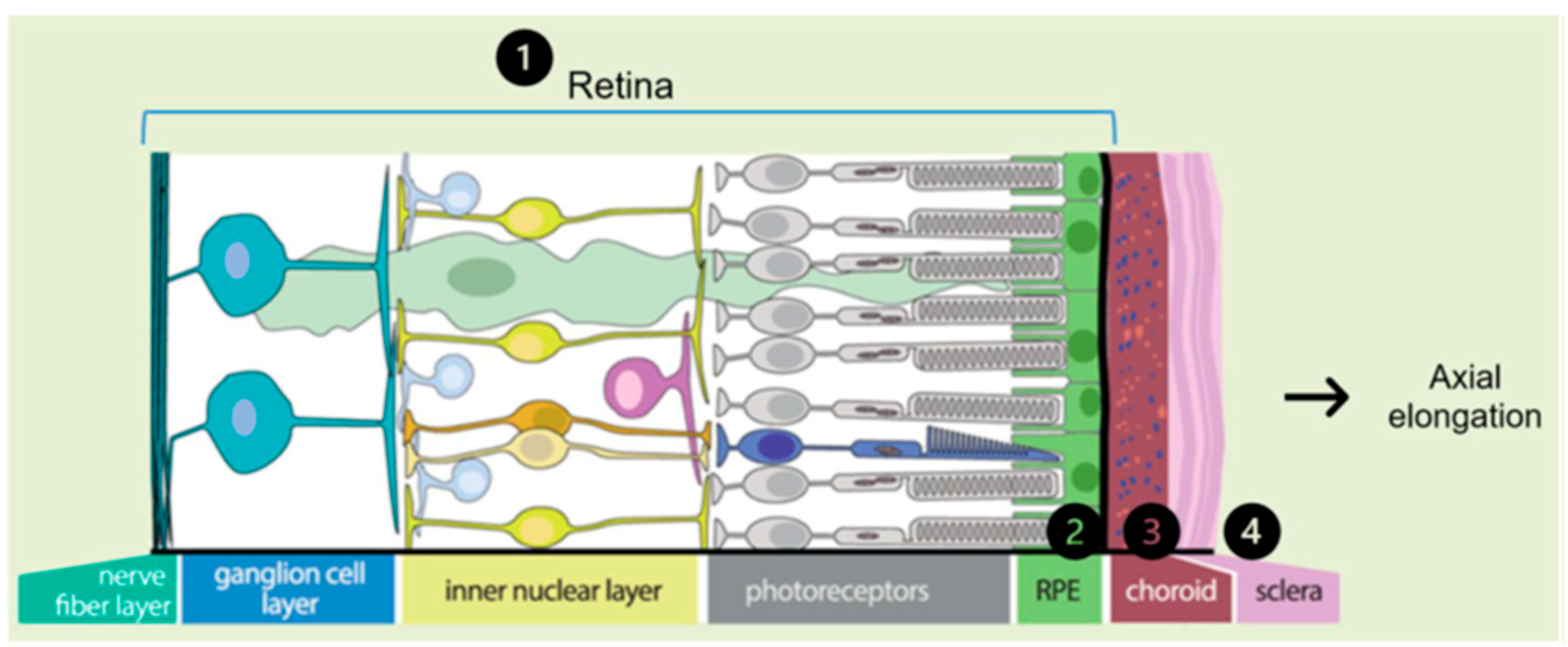
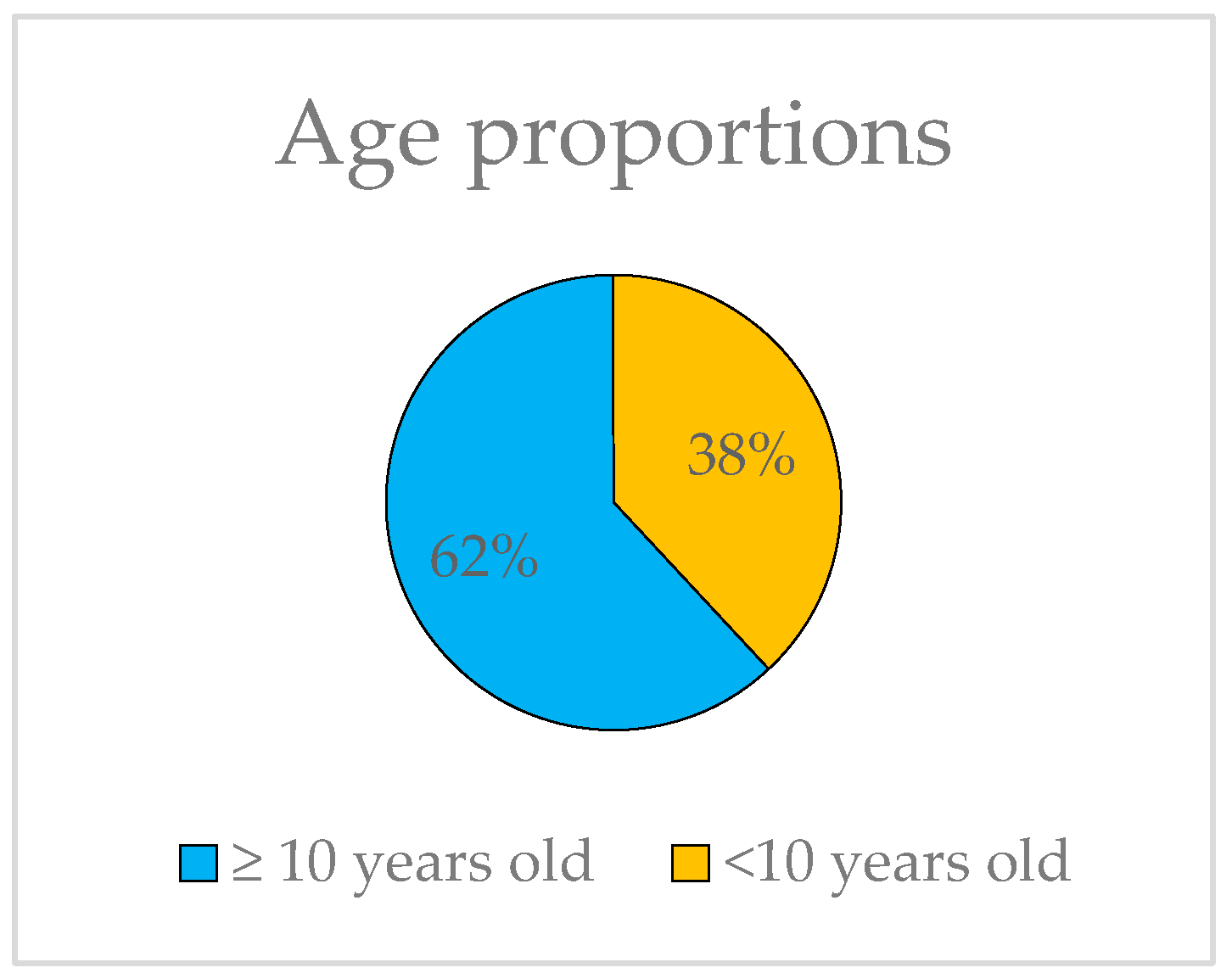
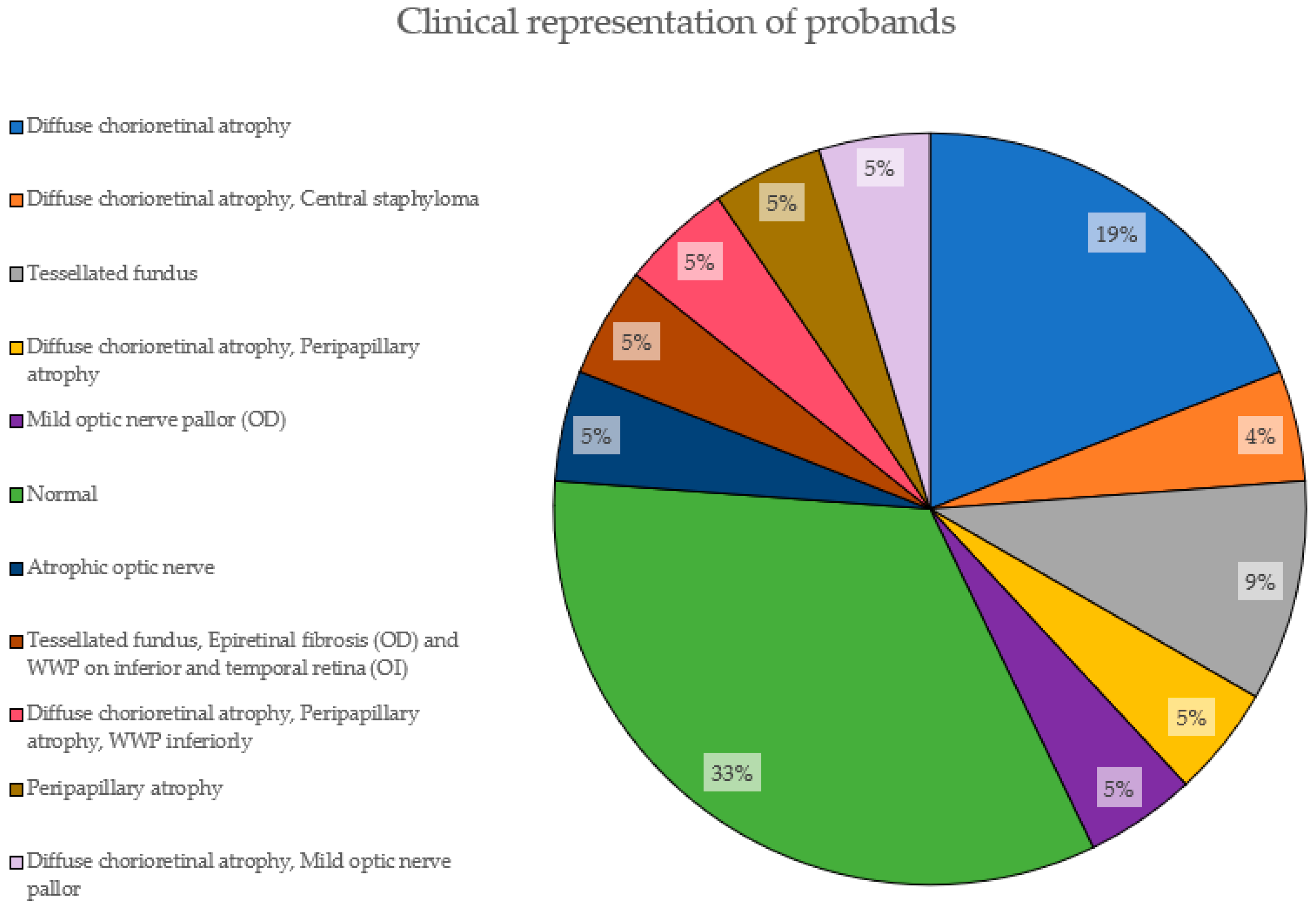

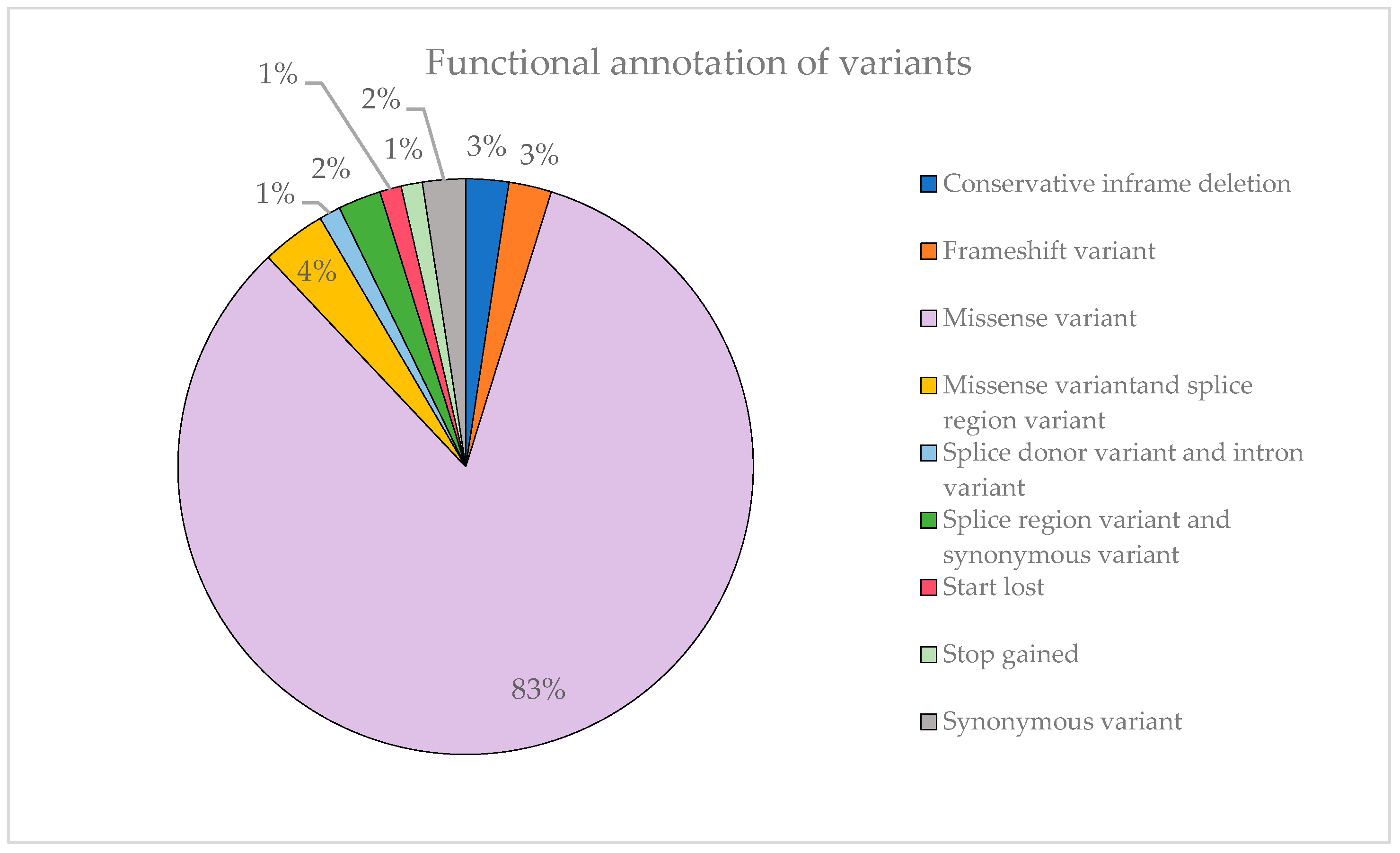
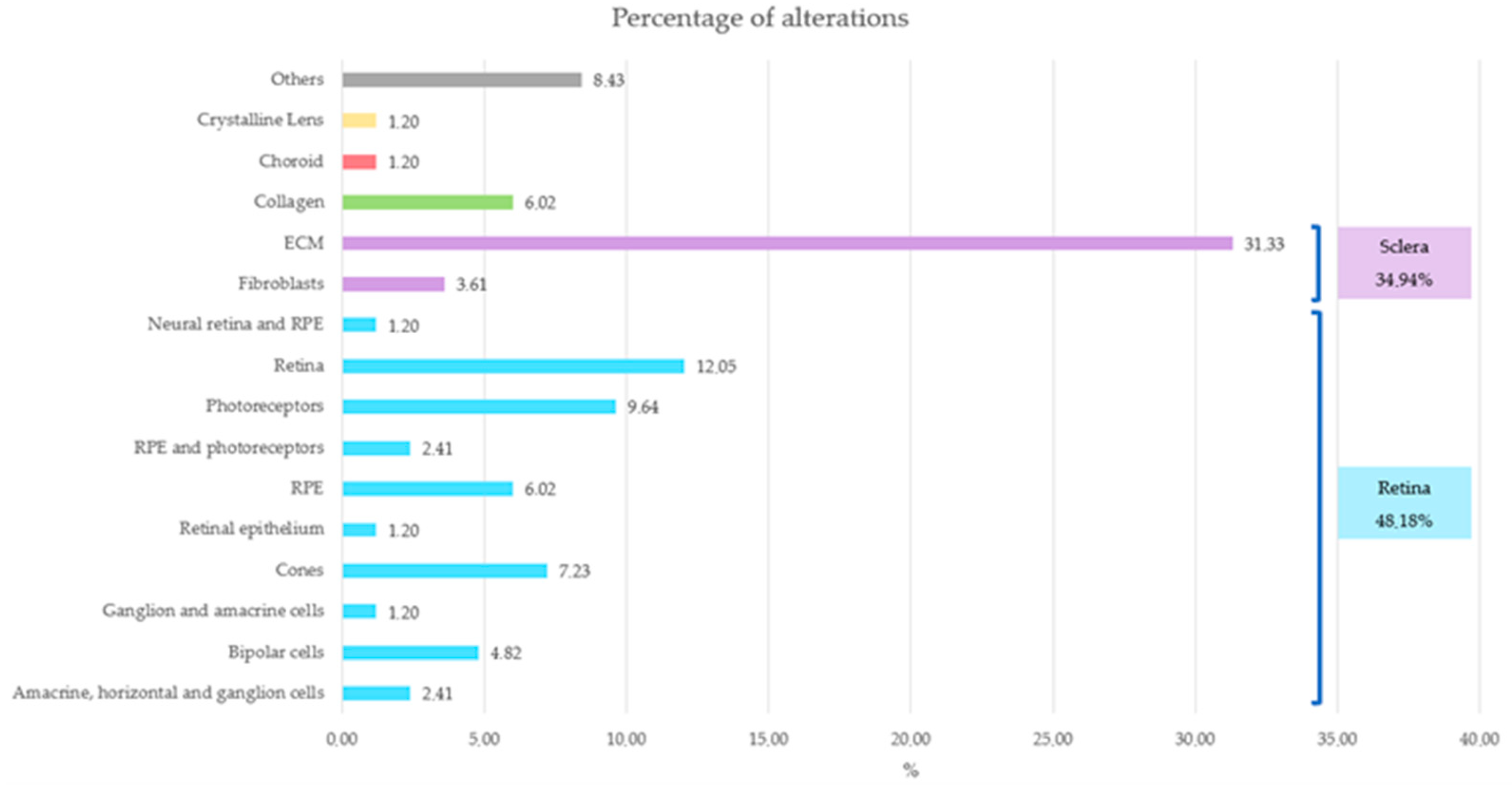
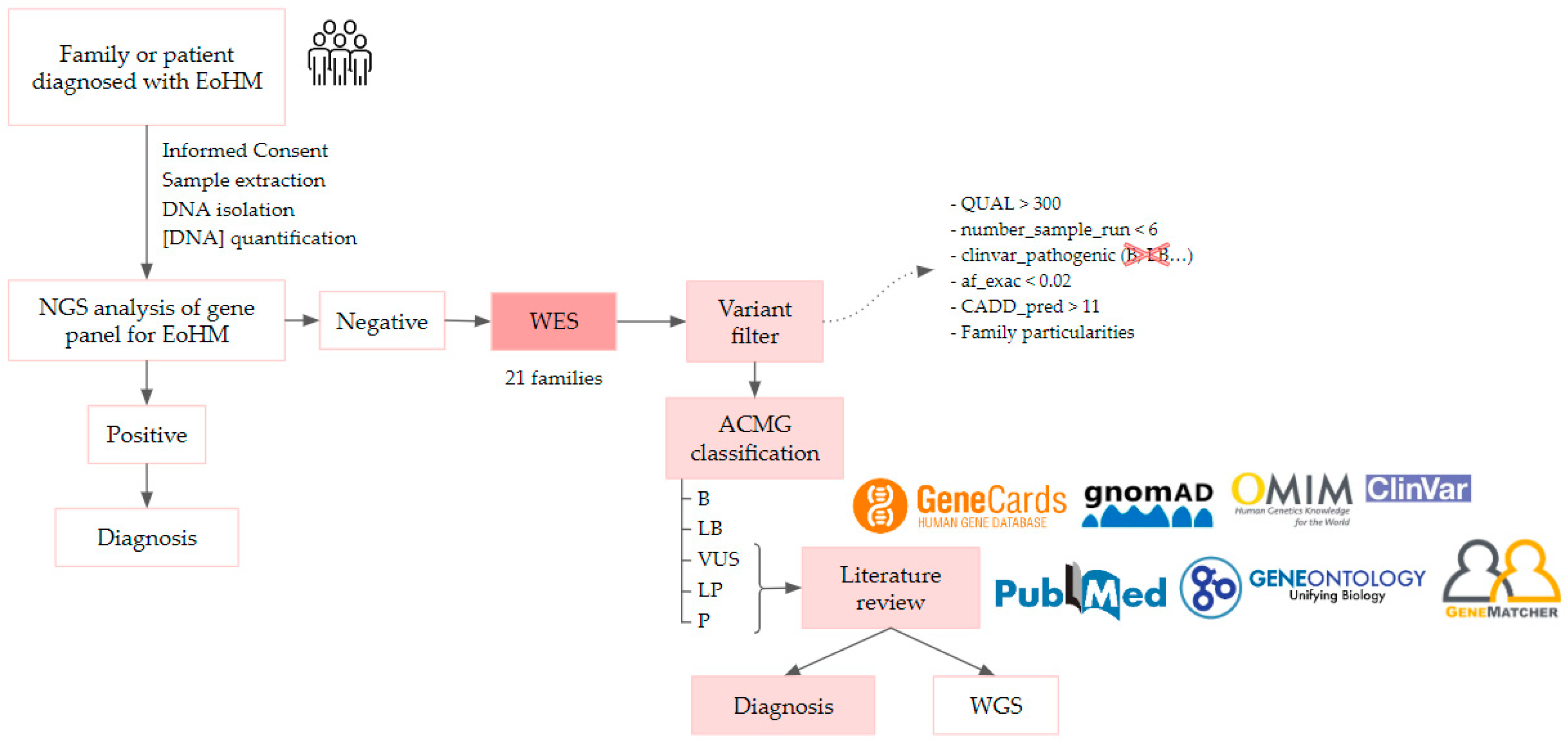
| Family ID | Gender | Actual Age | BCVA OD | BCVA OS | AL OD | AL OS | Funduscopic Examination OD | Funduscopic Examination OS | SPcc OD | Astig OD | SE OD cc | SPcc OS | Astig OS | SE OS cc |
|---|---|---|---|---|---|---|---|---|---|---|---|---|---|---|
| OFT-00074 | F | 16 | 0.6 | 0.08 | 26.6 | 26.93 | Diffuse chorioretinal atrophy, central staphyloma | Diffuse chorioretinal atrophy, central staphyloma | −12 | −0.5 | −12.25 | −12.75 | −2.5 | −14 |
| OFT-00097 | M | 8 | 0.4 | 0.2 | 26.84 | 26.47 | Tessellated fundus, healthy optic nerve | Tessellated fundus, healthy optic nerve | −9.75 | −5.25 | −12.35 | −10 | −5.25 | −12.6 |
| OFT-00155 | M | 12 | 0.125 | 0.1 | NA | NA | Healthy retina | Healthy retina | −10 | −1.25 | −10.6 | −8.75 | −2.75 | −10.1 |
| OFT-00175 | M | 16 | 0.9 | 0.8 | 31.22 | 30.98 | Diffuse chorioretinal atrophy, peripapillary atrophy | Diffuse chorioretinal atrophy, peripapillary atrophy | −13.5 | −4.75 | −15.87 | −13.25 | −6 | −16.25 |
| OFT-00178 | M | 7 | 0.3 | 0.4 | 26.75 | 26.65 | Healthy retina, mild optic nerve pallor | Healthy retina | −6.75 | −4 | −8.75 | −7.25 | −3.25 | −8.88 |
| OFT-00191 | M | 8 | 0.5 | 0.5 | 26.05 | 26.15 | Diffuse chorioretinal atrophy, mild optic nerve pallor | Diffuse chorioretinal atrophy, mild optic nerve pallor | −9 | −2 | −10 | −8.75 | −3.25 | −10.4 |
| OFT-00209 | M | 10 | 0.6 | 0.7 | NA | NA | Diffuse chorioretinal atrophy | Diffuse chorioretinal atrophy | −8.5 | −3 | −10 | −7 | −3 | −8.5 |
| OFT-00217 | F | 11 | 0.8 | 0.8 | NC | NC | Normal | Normal | −7.00 | −1.75 | −7.75 | −8.75 | −1.50 | −9.50 |
| OFT-00223 | F | 9 | 0.3 | 0.3 | 28.04 | 27.62 | Atrophic optic nerve | Atrophic optic nerve | −13.5 | −2.5 | −14.75 | −13 | −0.5 | −13.25 |
| OFT-00253 | F | 7 | 0.9 | 0.9 | 29.59 | 29.1 | Healthy retina | Healthy retina | −19.25 | 0 | −19.25 | −17.25 | −0.5 | −17.5 |
| OFT-00268 | M | 9 | 0.5 | 0.6 | 27.08 | 27.18 | Diffuse chorioretinal atrophy | Diffuse chorioretinal atrophy | −7.25 | −0.75 | −7.6 | −7 | −1 | −7.5 |
| OFT-00332 | M | 12 | 0.25 | 0.3 | 29.41 | 29.02 | Tessellated fundus, epiretinal fibrosis | Tessellated fundus, WWP on inferior and temporal retina | −15.25 | −1 | −15.75 | −14.75 | −0.5 | −15 |
| OFT-00403 | M | 9 | 1 | 0.8 | NC | NC | Normal | Normal | −14.75 | −1.00 | −15.25 | −15.00 | −0.75 | −15.25 |
| OFT-00429 | M | 36 | 0.8 | 0.6 | NA | NA | Diffuse chorioretinal atrophy, peripapillary atrophy, WWP inferiorly | Diffuse chorioretinal atrophy, peripapillary atrophy, WWP inferiorly | −20 | 0 | −20 | −19 | 0 | −19 |
| OFT-00474 | M | 6 | 0.1 | 0.7 | 27.43 | 25.99 | Diffuse chorioretinal atrophy | Diffuse chorioretinal atrophy | −11.5 | −1.25 | −12.125 | −10.25 | −0.5 | −10.5 |
| OFT-00477 | F | 11 | 1.25 | 1.25 | NA | NA | Healthy retina | Healthy retina | −7.5 | −0.75 | −7.875 | −8 | −1.5 | −8.75 |
| OFT-00506 | F | 16 | 0.7 | 0.7 | NA | NA | Tessellated fundus | Tessellated fundus | −13.25 | −2 | −14.25 | −12.5 | −1.5 | −13.25 |
| OFT-00546 | M | 12 | 1 | 1 | 24.45 | 24.12 | Healthy retina | Healthy retina | −7.25 | −0.75 | −7.625 | −5 | −1 | −5.5 |
| OFT-00586 | F | 80 | 0.8 | 0.05 | NA | NA | Diffuse chorioretinal atrophy | Diffuse chorioretinal atrophy | NA | NA | NA | NA | NA | NA |
| OFT-00601 | M | 13 | 1 | 0.9 | 27.92 | 27.68 | Healthy retina | Healthy retina | −7 | −1 | −7.5 | −6.5 | −1 | −7 |
| OFT-00710 | M | 10 | 0.8 | 0.9 | NC | NC | Peripapillary atrophy | Peripapillary atrophy | −8.50 | −5.50 | −10.25 | −6.00 | −6.00 | −9.00 |
| Right Eye | Left Eye | |
|---|---|---|
| SP cc (diopters) | −11.21 ± 4.098 | −10.632 ± 4.034 |
| Astig (diopters) | −1.95 ± 1.697 | −2.113 ± 1.858 |
| SE (diopters) | −12.044 ± 3.894 | −11.499 ± 3.81 |
| BCVA (decimal scale) | 0.649 ± 0.319 | 0.599 ± 0.333 |
| Female | Male | Total Female and Male | |
|---|---|---|---|
| More severe (<−10 SE cc) | 5 | 8 | 13 |
| Less severe (>−10 SE cc) | 2 | 6 | 8 |
| Total More and Less severe | 7 | 14 | 21 |
 | ACMG Criteria | ACMG Result | Variant | Zygosity | Inheritance | Total Families | Model of Inheritance | Gene Reported by |
|---|---|---|---|---|---|---|---|---|
| CACNA1F | PP3, PM2 | LP | NM_005183.3:c.2924G>A:p.(Arg975Gln) | Hemi | Maternal * | 2 | XL | [22,24] |
| COL9A3 | - | VUS | NM_001853.3:c.1258C>G:p.(Gln420Glu) | Het | Maternal | 2 | AD | [15] |
| HSPG2 | PM2 | VUS | NM_005529.6:c.4493C>T:p.(Ser1498Phe) | Het | Maternal * | 6 | AD/AR | [19] |
| LAMA1 | PM2, BP4 | VUS | NM_005559.3:c.3958A>G:p.(Ile1320Val) | Het | Maternal * | 2 | AR | [25,26,27] |
| LAMA5 | PM2 | VUS | NM_005560.4:c.1744C>T:p.(Pro582Ser) | Het | Maternal * | 2 | Unknown | [15] |
| THBS1 | PM2, BP4 | VUS | NM_003246.3:c.1122C>T:p.(Pro374Pro) | Het | Maternal * | 1 | Unknown | [28] |
| THBS2 | PM2 | VUS | NM_003247.3:c.1019C>T:p.(Thr340Met) | Het | Maternal* | 2 | Unknown | [28] |
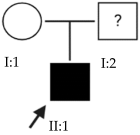 | ACMG Criteria | ACMG Result | Variant | Zygosity | Inheritance | Total Families | Model of Inheritance | Reported Gene by |
|---|---|---|---|---|---|---|---|---|
| COL9A1 | PM2, BP1 | VUS | NM_001851.4:c.6G>T:p.(Lys2Asn) | Het | Unknown | 1 | AR | [15] |
| GLB1 | PM2, PM5, PP3, PP2, PP5 | P | NM_000404.3:c.1498A>G:p.(Thr500Ala) | Het | Unknown | 1 | AR | [39] |
| KDM6B | PM2, BP4 | VUS | NM_001080424.1:c.3221C>G:p.(Ala1074Gly) | Het | Unknown | 2 | Unknown | [17] |
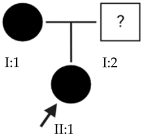 | ACMG Criteria | ACMG Result | Variant | Zygosity | Inheritance | Total Families | Model of Inheritance | Gene Reported by |
|---|---|---|---|---|---|---|---|---|
| ALKBH5 | PM2, BP4 | VUS | NM_017758.3:c.952C>A:p.(Pro318Thr) | Het | Maternal | 1 | Unknown | [44] |
| USH2A | PM2, BP4 | VUS | NM_206933.2:c.15172T>C:p.(Phe5058Leu) | Het | Maternal | 2 | AR | [19,24] |
 | ACMG Criteria | ACMG Result | Variant | Zygosity | Inheritance | Total Families | Model of Inheritance | Gene Reported by |
|---|---|---|---|---|---|---|---|---|
| CSMD1 | PM2, PP3 | VUS | NM_033225.5:c.9089C>G:p.(Pro3030Arg) | Het | Maternal | 4 | Unknown | [19,23] |
| CSMD1 | PM2, BP4 | VUS | NM_033225.5:c.7050T>A:p.(Ser2350Arg) | Het | Maternal | 4 | Unknown | [19,23] |
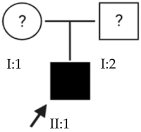 | ACMG Criteria | ACMG Result | Variant | Zygosity | Inheritance | Total Families | Model of Inheritance | Gene Reported by |
|---|---|---|---|---|---|---|---|---|
| ARHGEF15 | PM2, BP4 | VUS | NM_173728.3:c.380C>G:p.(Pro127Arg) | Het | Paternal | 1 | Unknown | [51] |
| CFH | PM2, BS2 | VUS | NM_000186.3:c.481G>T:p.(Ala161Ser) | Het | Maternal | 1 | AD/AR | [52] |
| CPSF1 | PM2, PP3 | VUS | NM_013291.2:c.2383G>A:p.(Glu795Lys) | Het | Paternal | 2 | Unknown | [40,45,46] |
| HSPG2 | PM2 | VUS | NM_005529.6:c.4078A>G:p.(Asn1360Asp) | Het | Paternal | 6 | AD/AR | [19] |
| LRP1 | PM2, PP2, BP6 | VUS | NM_002332.2:c.11930C>T:p.(Ser3977Leu) | Het | Paternal | 2 | AD/AR | [43] |
| ZNF644 | PM2 | VUS | NM_201269.2:c.1366A>T:p.(Thr456Ser) | Het | Maternal | 1 | AD | [49,50] |
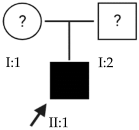 | ACMG Criteria | ACMG Result | Variant | Zygosity | Inheritance | Total Families | Model of Inheritance | Gene Reported by |
|---|---|---|---|---|---|---|---|---|
| FRMPD1 | PM2, PP3 | VUS | NM_014907.2:c.925G>A:p.(Ala309Thr) | Het | Paternal | 2 | Unknown | [38] |
| LAMA1 | - | VUS | NM_005559.3:c.781A>G:p.(Ile261Val) | Het | Paternal | 2 | AR | [25,26,27] |
| PRIMPOL | PM2, BP4 | VUS | NM_152683.3:c.1380T>C:p.(Cys460Cys) | Het | Paternal | 1 | AD | [58,59,60] |
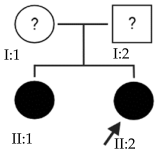 | ACMG Criteria | ACMG Result | Variant | Zygosity | Inheritance | Total Families | Model of Inheritance | Gene Reported by |
|---|---|---|---|---|---|---|---|---|
| TSG101 | PM2 | VUS | NM_006292.3:c.942C>T:p.(Ile314Ile) | Het | Paternal | 3 | Unknown | [53] |
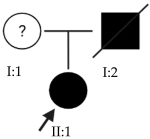 | ACMG Criteria | ACMG Result | Variant | Zygosity | Inheritance | Total Families | Model of Inheritance | Gene Reported by |
|---|---|---|---|---|---|---|---|---|
| COL9A3 | PM2 | VUS | NM_001853.3:c.1511C>T:p.(Pro504Leu) | Het | Unknown | 2 | AD | [15] |
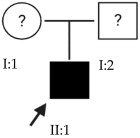 | ACMG Criteria | ACMG Result | Variant | Zygosity | Inheritance | Total Families | Model of Inheritance | Gene Reported by |
|---|---|---|---|---|---|---|---|---|
| ABCA4 | PS4, PP3, PP2, BS1, PP5, BP6 | VUS | NM_000350.2:c.6148G>C:p.(Val2050Leu) | Het | Paternal | 1 | AR | [19,24] |
| AGRN | PM2 | VUS | NM_198576.3:c.2737G>A:p.(Val913Met) | Het | Paternal | 2 | AR | [40] |
| FLRT3 | PM2 | VUS | NM_013281.3:c.1135G>A:p.(Gly379Arg) | Het | Maternal | 2 | AD/Digenic/Multigenic | [57] |
| LAMA2 | PM2 | VUS | NM_000426.3:c.6880G>T:p.(Val2294Leu) | Het | Paternal | 1 | AD/AR | [61,62] |
| LAMA5 | PM2 | VUS | NM_005560.4:c.11063G>A:p.(Gly3688Glu) | Het | Maternal | 2 | Unknown | [15] |
| LTBP2 | PM2, PP3 | VUS | NM_000428.2:c.3998G>C:p.(Gly1333Ala) | Het | Paternal | 3 | AR | [15,24] |
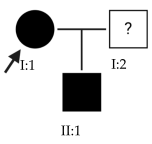 | ACMG Criteria | ACMG Result | Variant | Zygosity | Inheritance | Total Families | Model of Inheritance | Gene Reported by |
|---|---|---|---|---|---|---|---|---|
| BICC1 | PM2 | VUS | NM_001080512.2:c.1425G>C:p.(Leu475Phe) | Het | Maternal | 1 | AD | [63,64] |
| CNTN4 | PM2 | VUS | NM_001206955.1:c.2128G>A:p.(Gly710Arg) | Het | Maternal | 1 | Unknown | [42] |
| LTBP2 | BP4 | VUS | NM_000428.2:c.1487G>A:p.(Gly496Asp) | Het | Maternal | 3 | AR | [15,24] |
| TSG101 | PM2 | VUS | NM_006292.3:c.307G>A:p.(Val103Ile) | Het | Maternal | 3 | Unknown | [53] |
 | ACMG Criteria | ACMG Result | Variant | Zygosity | Inheritance | Total Families | Model of Inheritance | Gene Reported by |
|---|---|---|---|---|---|---|---|---|
| CSMD1 | PM2 | VUS | NM_033225.5:c.5600C>G:p.(Pro1867Arg) | Het | Maternal | 4 | Unknown | [19,23] |
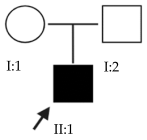 | ACMG Criteria | ACMG Result | Variant | Zygosity | Inheritance | Total Families | Model of Inheritance | Gene Reported by |
|---|---|---|---|---|---|---|---|---|
| FBN1 | PM2, PP2 | VUS | NM_000138.4:c.8195G>C:p.(Ser2732Thr) | Het | Maternal | 1 | AD | [15] |
| LTBP2 | PM2 | VUS | NM_000428.2:c.2512G>A:p.(Val838Met) | Het | Maternal | 3 | AR | [15,24] |
| USH2A | PM2, BP4 | VUS | NM_206933.2:c.9776T>C:p.(Val3259Ala) | Het | Maternal | 2 | AR | [19,24] |
| Code | Description | Filter |
|---|---|---|
| QUAL | Quality of the variation found. | >300 |
| number_sample_run | Number of people in that run with the same variant. | <6 |
| clinvar_pathogenic | Prediction of variant pathogenicity based on Clinvar database. | Benign and Likely Benign discarded |
| af_exac_all | Allele frequency in the global population according to Exome Aggregation Consortium (ExAC). | <0.02 |
| af_exac_afr | Allele frequency in the African population according to ExAC. | <0.02 |
| af_exac_amr | Allele frequency in the American population according to ExAC. | <0.02 |
| af_exac_eas | Allele frequency in the East Asian population according to ExAC. | <0.02 |
| af_exac_fin | Allele frequency in the Finnish population according to ExAC. | <0.02 |
| af_exac_nfe | Allele frequency in the Non-Finnish European population according to ExAC. | <0.02 |
| af_exac_sas | Allele frequency in the South Asian population according to ExAC. | <0.02 |
| af_exac_oth | Allele frequency in the other population according to ExAC. | <0.02 |
| CADD_pred | Prediction of variant pathogenicity based on Combined Annotation Dependent Depletion (CADD) score. | Benign discarded |
| Family particularities | Depending on the affected subjects in every family. |
Disclaimer/Publisher’s Note: The statements, opinions and data contained in all publications are solely those of the individual author(s) and contributor(s) and not of MDPI and/or the editor(s). MDPI and/or the editor(s) disclaim responsibility for any injury to people or property resulting from any ideas, methods, instructions or products referred to in the content. |
© 2023 by the authors. Licensee MDPI, Basel, Switzerland. This article is an open access article distributed under the terms and conditions of the Creative Commons Attribution (CC BY) license (https://creativecommons.org/licenses/by/4.0/).
Share and Cite
Sánchez-Cazorla, E.; González-Atienza, C.; López-Vázquez, A.; Arruti, N.; Nieves-Moreno, M.; Noval, S.; Mena, R.; Rodríguez-Jiménez, C.; Rodríguez-Solana, P.; González-Iglesias, E.; et al. Whole-Exome Sequencing of 21 Families: Candidate Genes for Early-Onset High Myopia. Int. J. Mol. Sci. 2023, 24, 15676. https://doi.org/10.3390/ijms242115676
Sánchez-Cazorla E, González-Atienza C, López-Vázquez A, Arruti N, Nieves-Moreno M, Noval S, Mena R, Rodríguez-Jiménez C, Rodríguez-Solana P, González-Iglesias E, et al. Whole-Exome Sequencing of 21 Families: Candidate Genes for Early-Onset High Myopia. International Journal of Molecular Sciences. 2023; 24(21):15676. https://doi.org/10.3390/ijms242115676
Chicago/Turabian StyleSánchez-Cazorla, Eloísa, Carmen González-Atienza, Ana López-Vázquez, Natalia Arruti, María Nieves-Moreno, Susana Noval, Rocío Mena, Carmen Rodríguez-Jiménez, Patricia Rodríguez-Solana, Eva González-Iglesias, and et al. 2023. "Whole-Exome Sequencing of 21 Families: Candidate Genes for Early-Onset High Myopia" International Journal of Molecular Sciences 24, no. 21: 15676. https://doi.org/10.3390/ijms242115676
APA StyleSánchez-Cazorla, E., González-Atienza, C., López-Vázquez, A., Arruti, N., Nieves-Moreno, M., Noval, S., Mena, R., Rodríguez-Jiménez, C., Rodríguez-Solana, P., González-Iglesias, E., Guerrero-Carretero, M., D’Anna Mardero, O., Coca-Robinot, J., Acal, J. C., Blasco, J., Castañeda, C., Fraile Maya, J., Del Pozo, Á., Gómez-Pozo, M. V., ... Vallespín, E. (2023). Whole-Exome Sequencing of 21 Families: Candidate Genes for Early-Onset High Myopia. International Journal of Molecular Sciences, 24(21), 15676. https://doi.org/10.3390/ijms242115676








